Ohio Reptiles and Amphibians, 2015
Here are some reptiles, amphibians, and a few other things that I observed
in southeastern Ohio in 2015, in mostly chronological order.
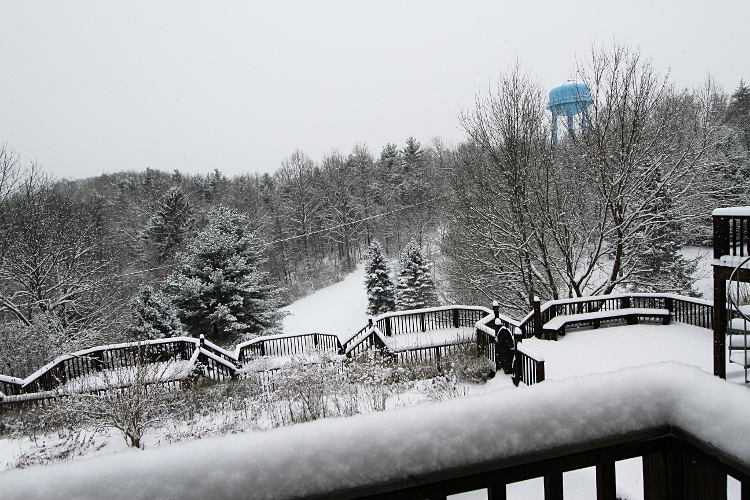
Our backyard, on an early morning January. Winter again turned out to be
pretty brutal this year.
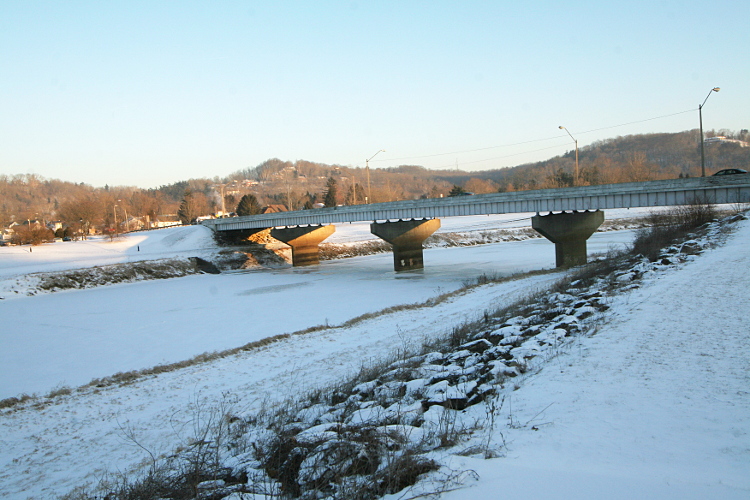
We had a cold spell in February where the Hocking River nearly completely
froze over. You don't see that too often here. This is looking downstream
at the Stimson Avenue bridge.

The Wood Frogs (Rana sylvatica) first arrived at our pool on the
night of March 13/14. I saw about six in the pool, including this one,
on March 14. They appeared to all be males. The first egg masses appeared
after the following night.
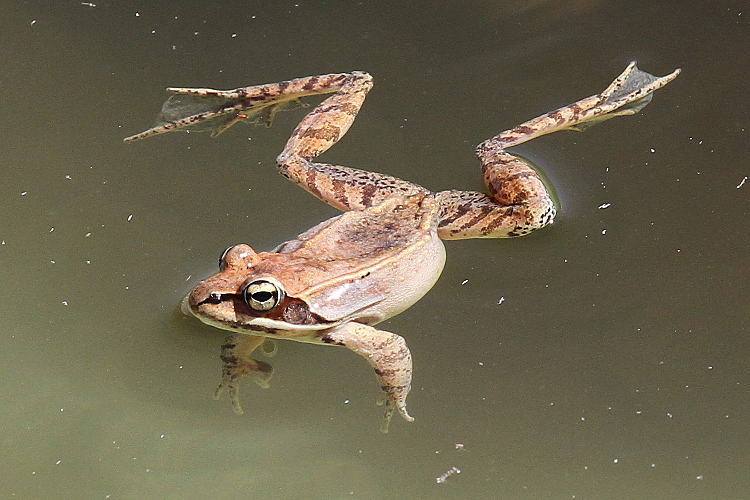
Another Wood Frog, observed on March 15.
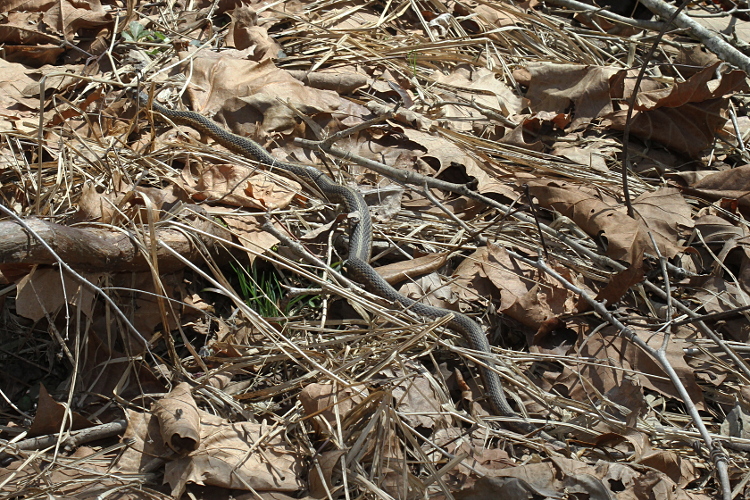
A Common Gartersnake (Thamnophis sirtalis), as spotted near a
vernal pool on March 21. It's always nice to get the first reptile of
the season in March.
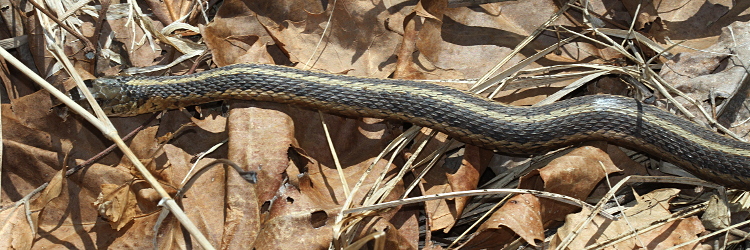
A closer look at the Gartersnake.
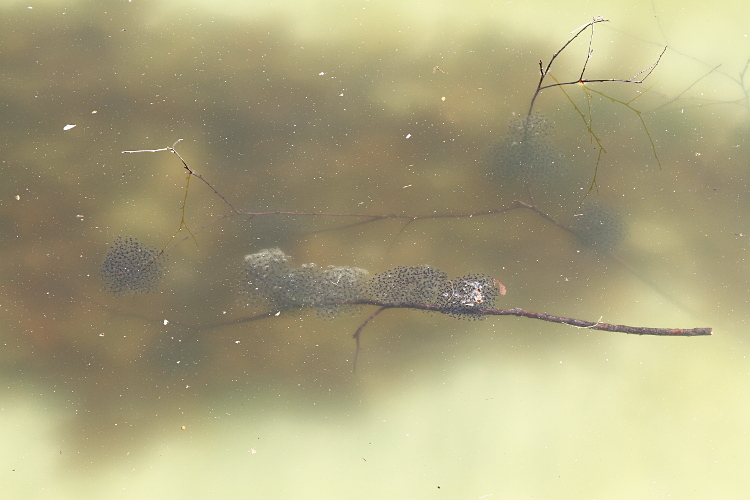
Wood Frog eggs in our pool on March 22. We put the sticks in there, because
we've noticed that they like to attach their eggs to sticks, but for
whatever reason no sticks were blown into the pool this winter.
On this day I counted at least 12 egg masses.
This is the most I have ever seen in our pool. Note that they did not discover
our pool was useful for breeding purposes until March 2012, so maybe
the increase in numbers is just a matter of them becoming more established
in the area.
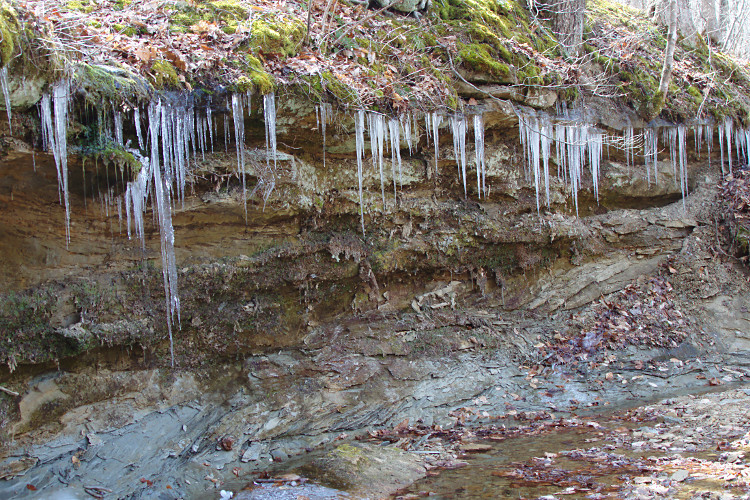
Old Man Winter, still bearing his teeth at the end of March.
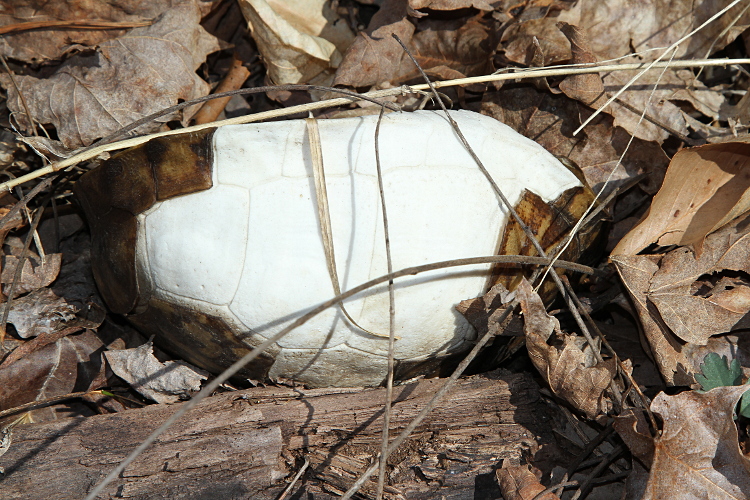
An old An Eastern Box Turtle (Terrapene carolina) shell. The white
on these really stands out.

This roadside ditch had calling
Mountain Chorus Frogs (Pseudacris brachyphona) and
nesting Four-toed Salamanders (Hemidactylium scutatum) in it.
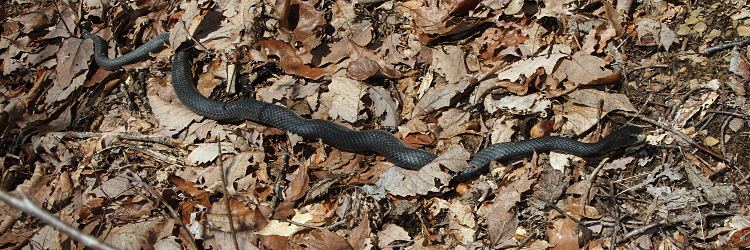
A Black Racer (Coluber constrictor), as found basking in
early April.
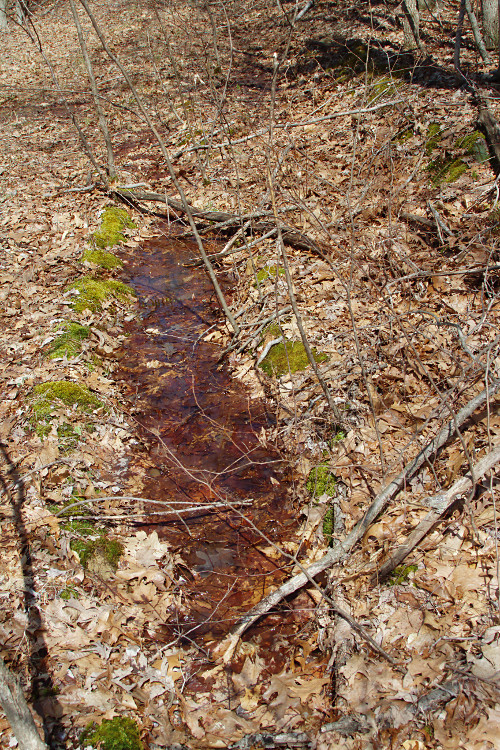
This ditch along an abandoned ridgetop road had nesting
Four-toed Salamanders (Hemidactylium scutatum) in it.
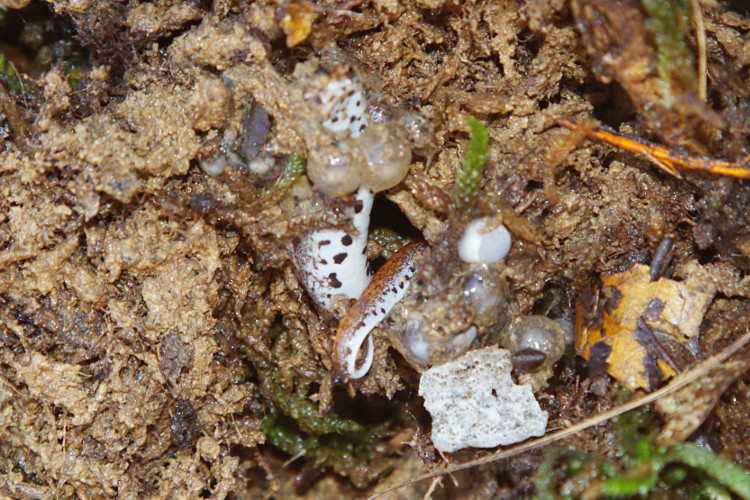
A nesting Four-toed.
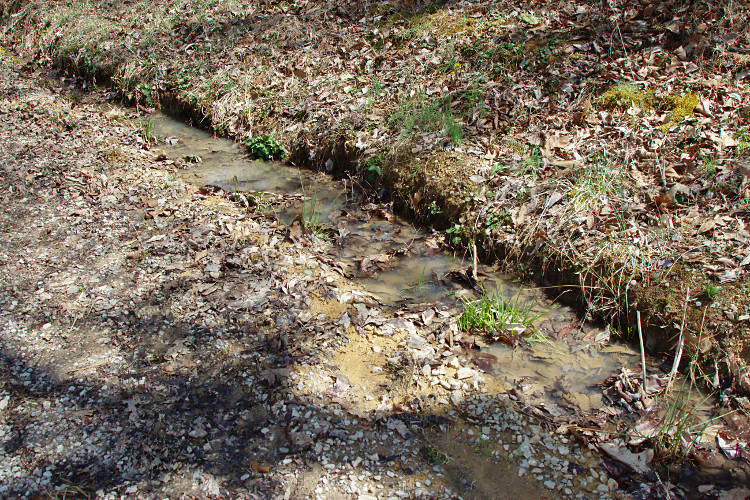
Another roadside ditch on a ridgetop. This one had
nesting Four-toeds, calling
Mountain Chorus Frogs (Pseudacris brachyphona),
and Spotted Salamander (Ambystoma maculatum) eggs in it.
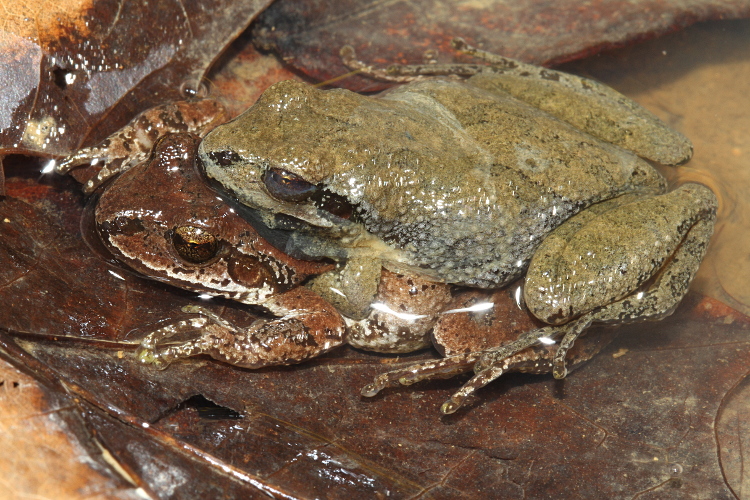
Amplectant Mountain Chorus Frogs observed on April 4.
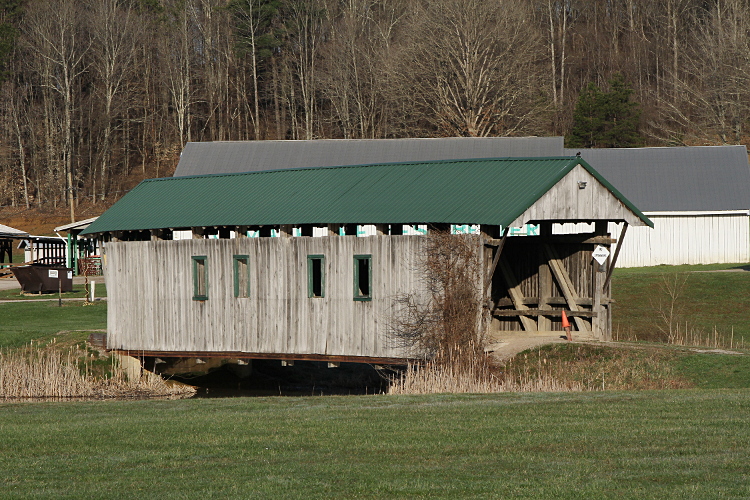
The Bay Covered Bridge. It was built in 1876. Nowadays, it spans part of a
pond on the the Vinton County Fairgrounds, just north of MacArthur, Ohio.
It was moved here in 1966 when nearby Lake Rupert was constructed.
It is nice that they saved it.
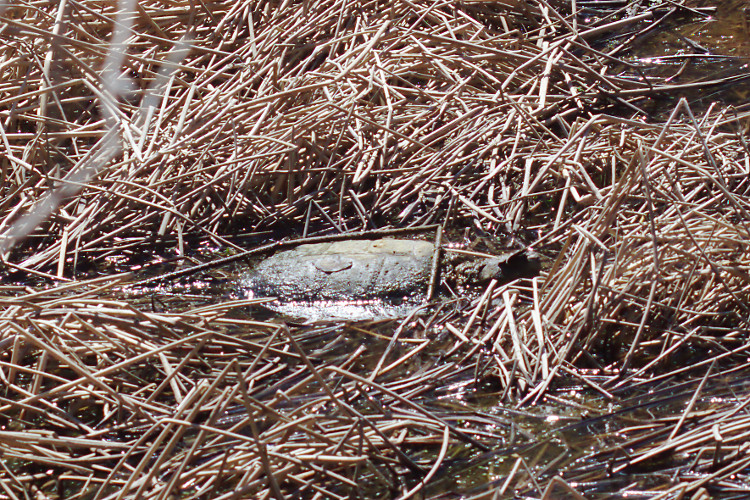
A large Snapping Turtle (Chelydra serpentina).
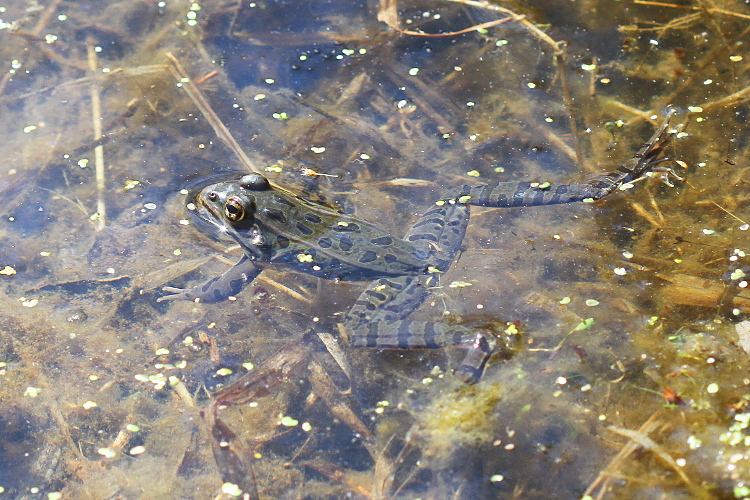
Northern Leopard Frog (Rana pipiens).

Amplectant Northern Leopard Frog (Rana pipiens).
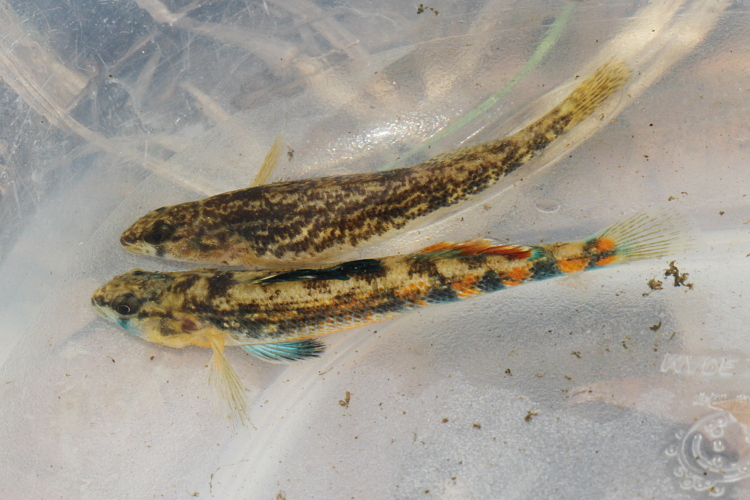
Orangethroat Darters (Etheostoma spectabile).
Female (top) and male (bottom).
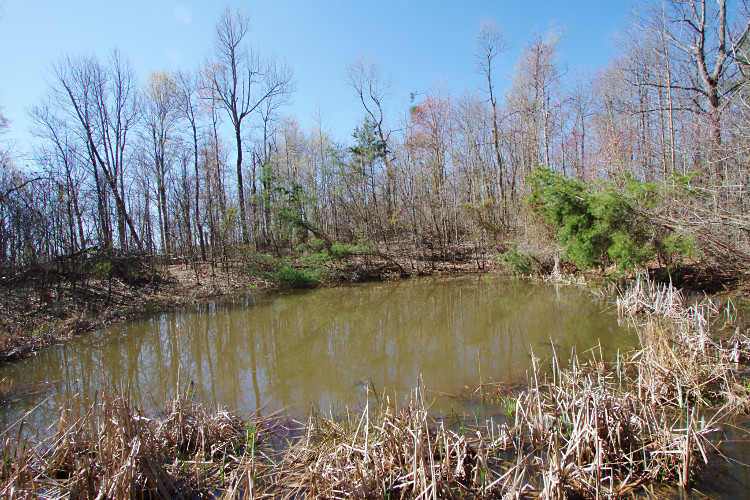
This pond is located on a ridgetop and was abandoned long ago.
There were many nesting Four-toed Salamanders (Hemidactylium scutatum)
in the moss on the far shore.
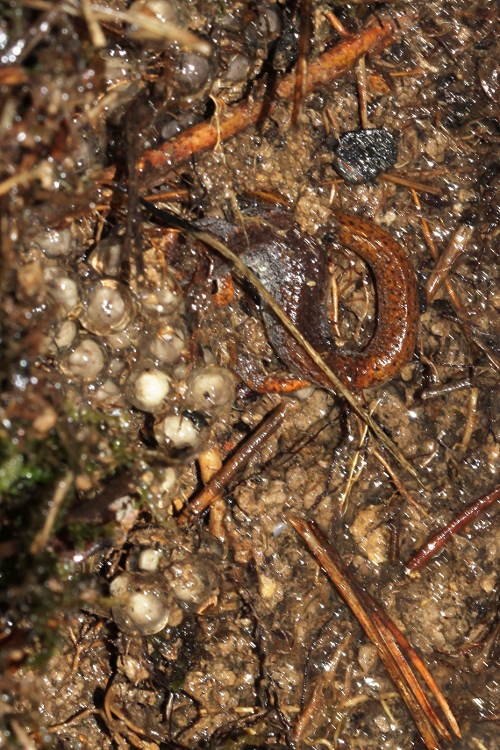
A Four-toed and nest, as found.
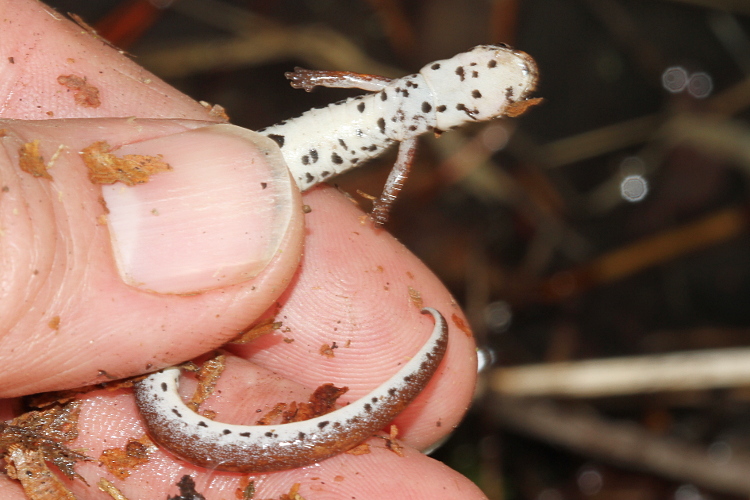
A ventral shot of a Four-toed.
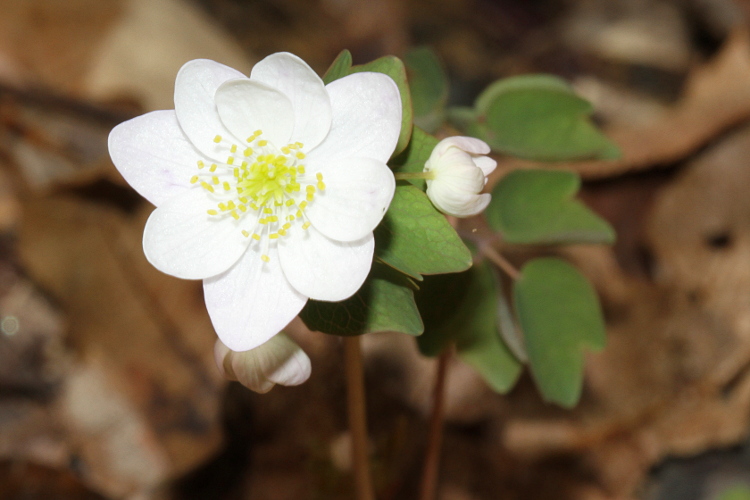
Rue Anemone (Thalictrum thalictroides).
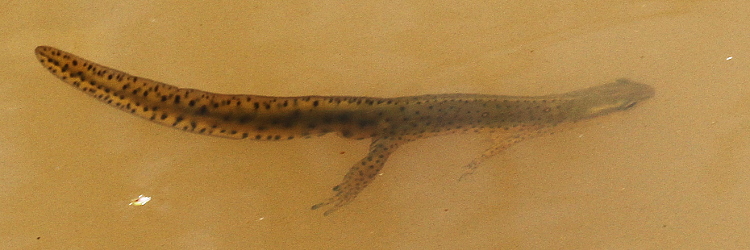
An Eastern Newt (Notophthalmus viridescens), as found
floating in a small pool.
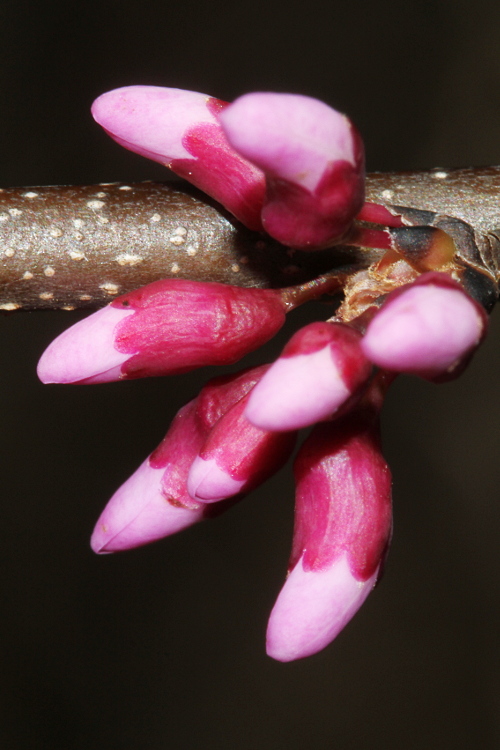
Redbud buds.
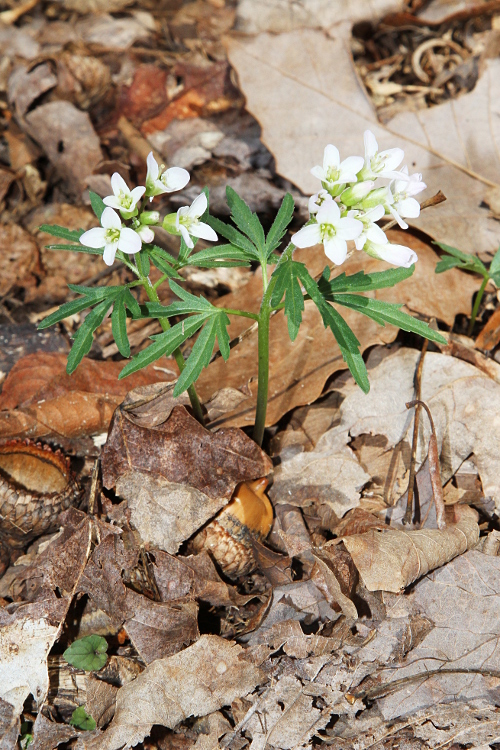
Cutleaf Toothwort (Cardamine concatenata).

A Mud Salamander (Pseudotriton montanus) larva.

A closer look.
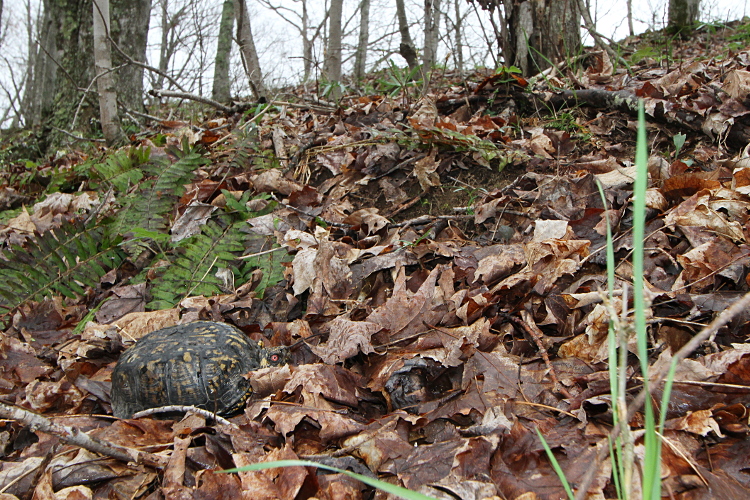
An Eastern Box Turtle (Terrapene carolina), as found near a ridgetop.
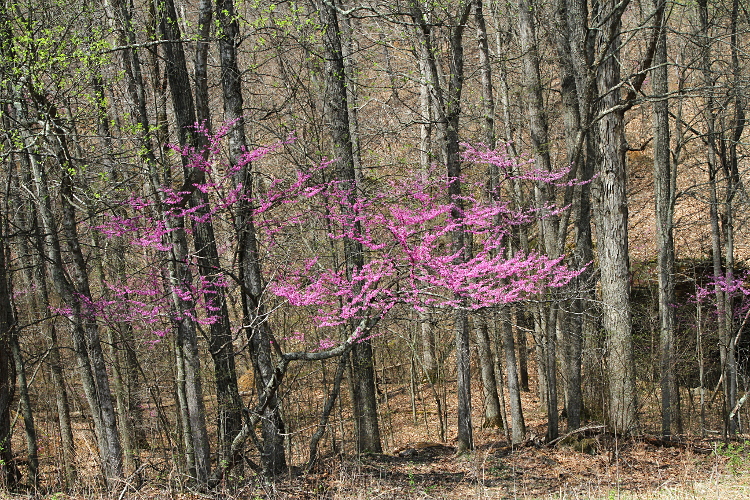
Redbuds.
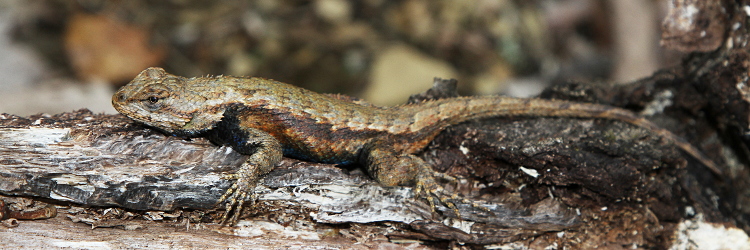
An Eastern Fence Lizard (Sceloporus undulatus), on a log.
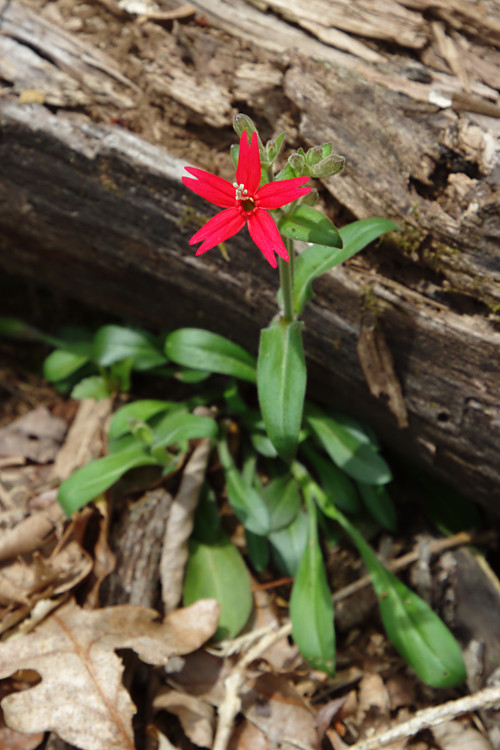
Fire Pink (Silene virginica).

Our pool on April 18.
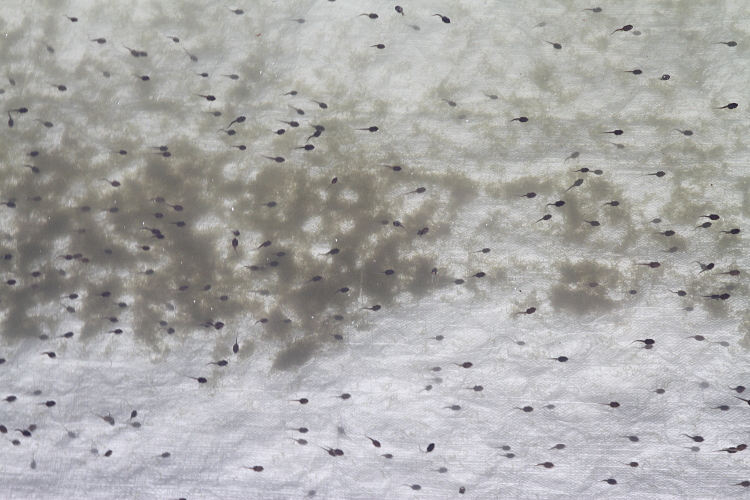
Wood Frog tadpoles (Rana sylvatica) in our pool on April 18.
There wound up being about 20 Wood Frog egg masses laid in our pool this year.
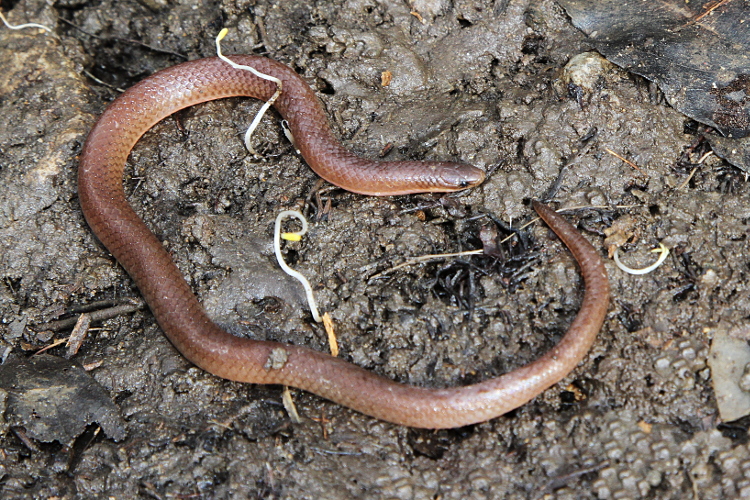
A Worm Snake (Carphophis amoenus), as found under cover.
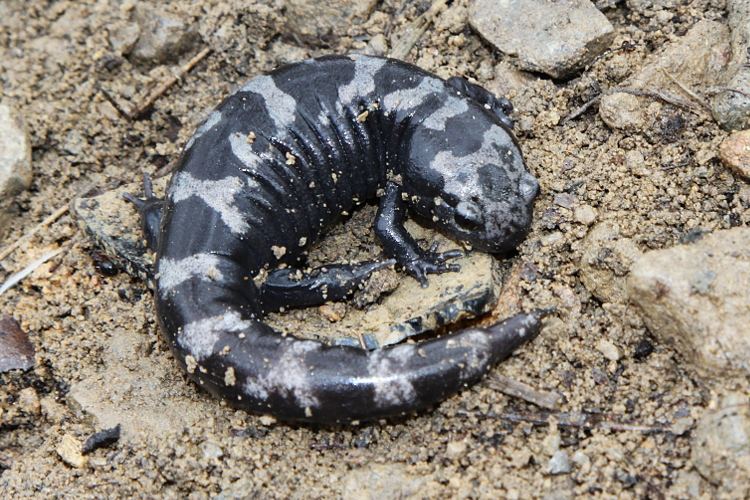
A Marbled Salamander (Ambystoma opacum), as found under cover.
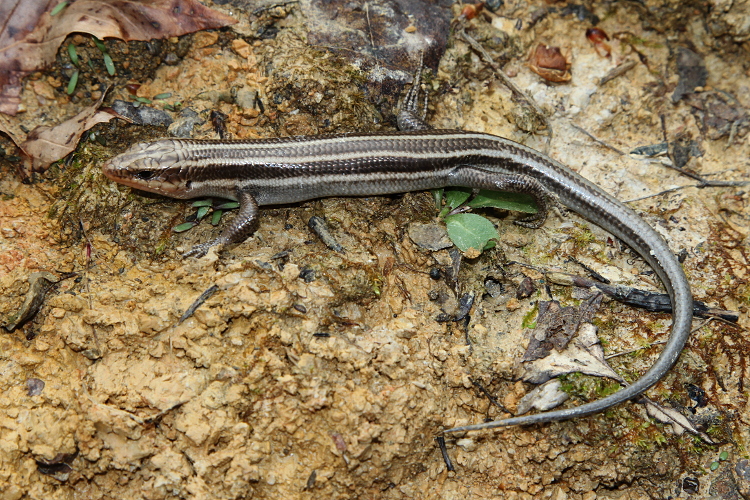
Five-lined Skink (Eumeces fasciatus).
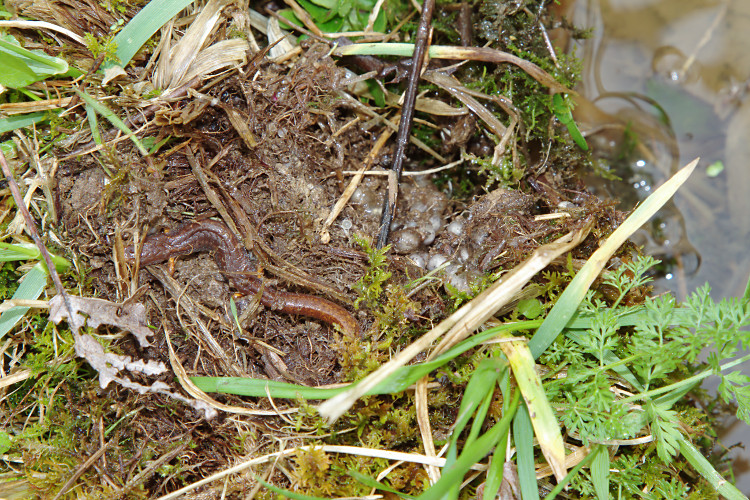
A Four-toed Salamander (Hemidactylium scutatum) found with eggs.
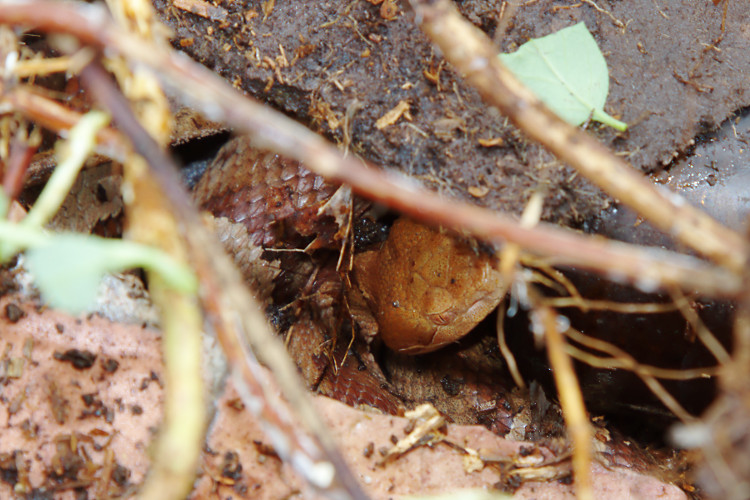
A Copperhead (Agkistrodon contortrix) found on April 26,
giving me the stink eye.
I found it in a trash pile, and did not try digging it out any further
than this.
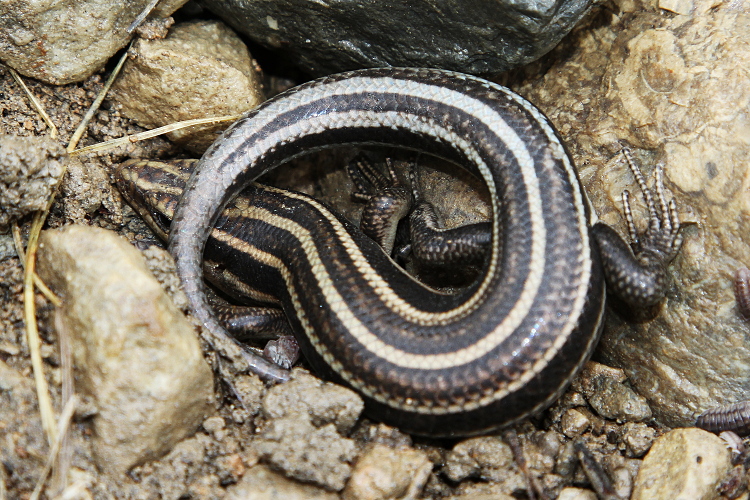
A Five-lined Skink (Eumeces fasciatus), as found under a rock.
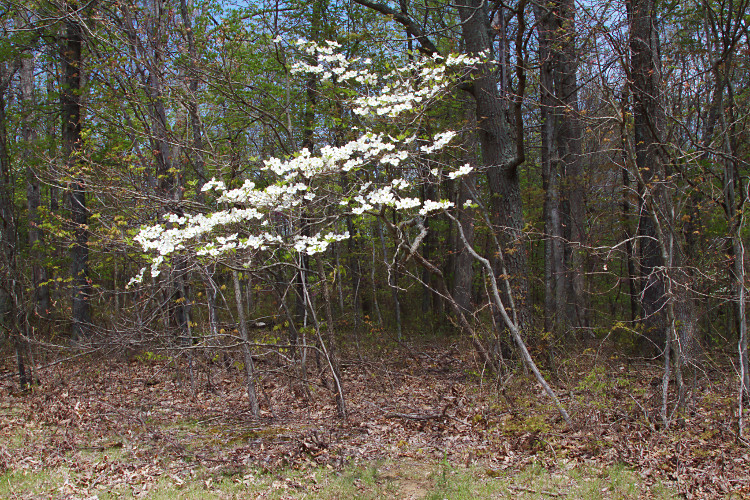
Dogwoods in bloom, late April.
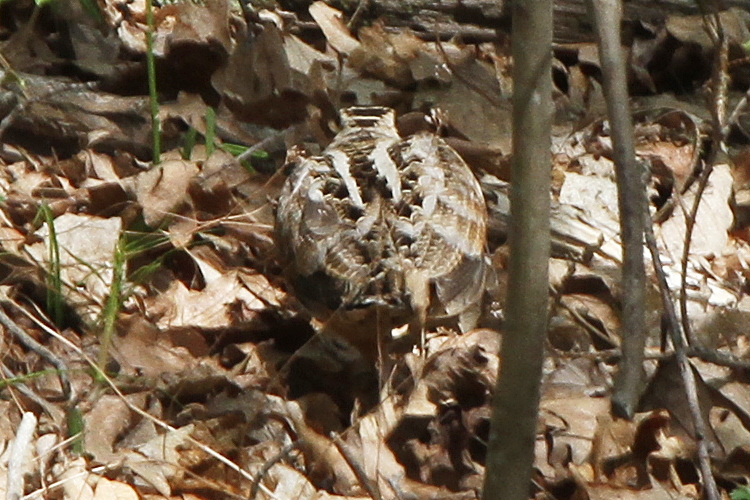
An American Woodcock (Scolopax minor). I came across a mom with
three young ones. The mom ran off, making a racket, to distract me from
babies.
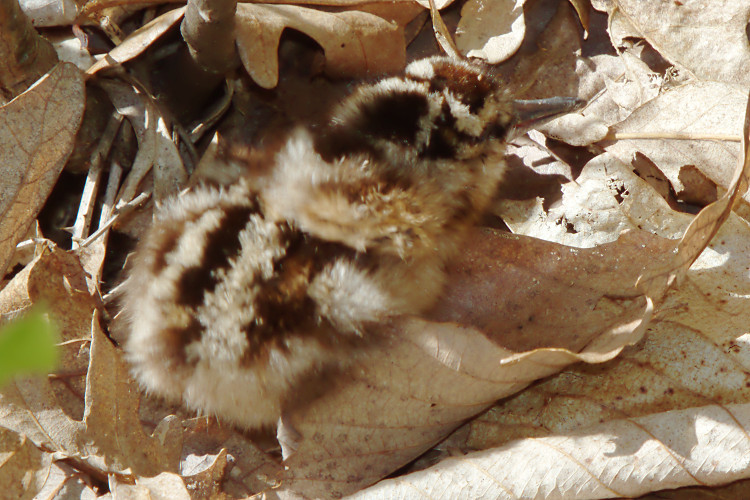
A Wooodcock chick. I just wish the photos of these had come out better.

Blue Phlox (Phlox divaricata).
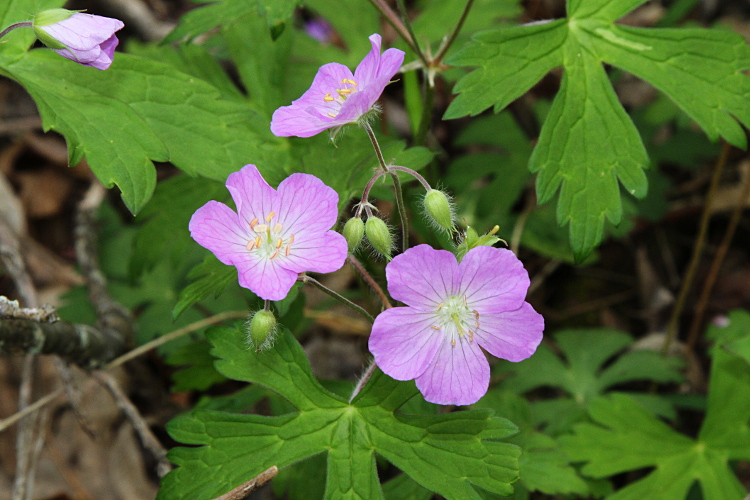
Wild Geranium (Geranium maculatum).
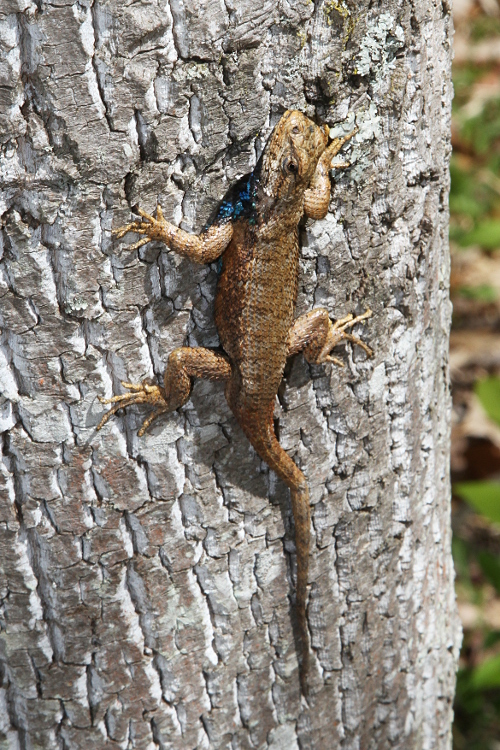
An Eastern Fence Lizard (Sceloporus undulatus), on a tree.
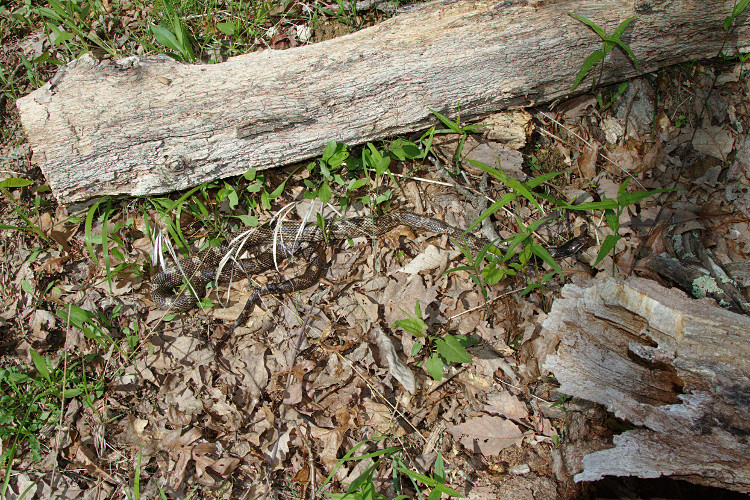
A Black Ratsnake (Elaphe obsoleta), as spotted basking next to a
hollow log. It appears to be digesting a meal -- perhaps a bunch of nestlings?
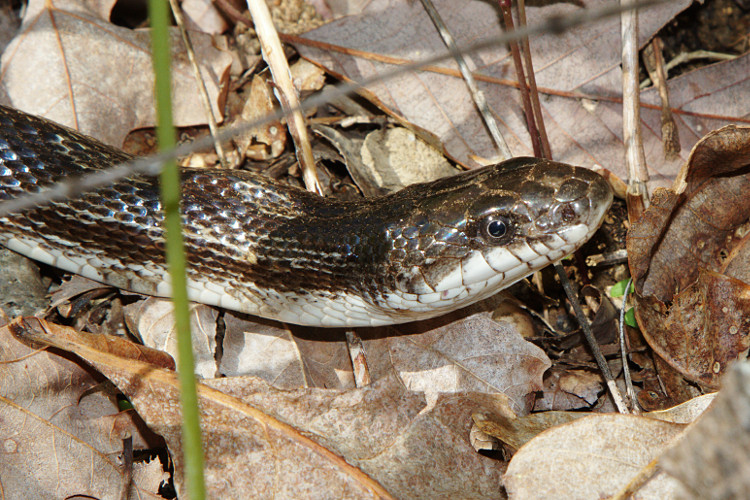
A closer look at the Black Ratsnake.

Ring-necked Snake (Diadophis punctatus).
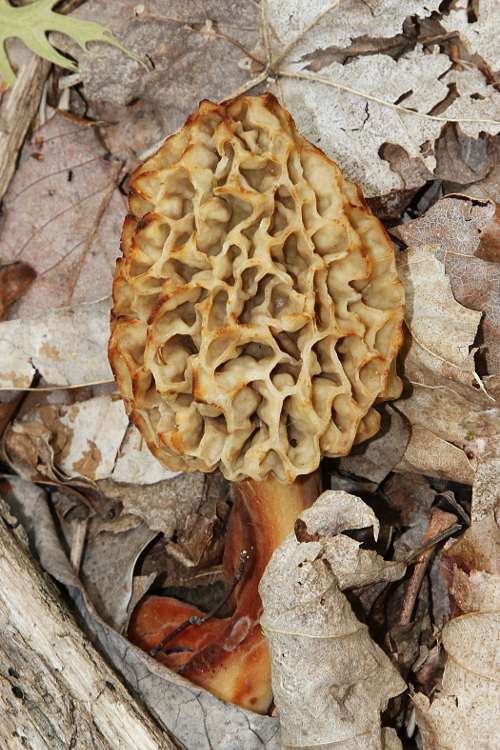
A Morel Mushroom. Looks to be a little past its prime.
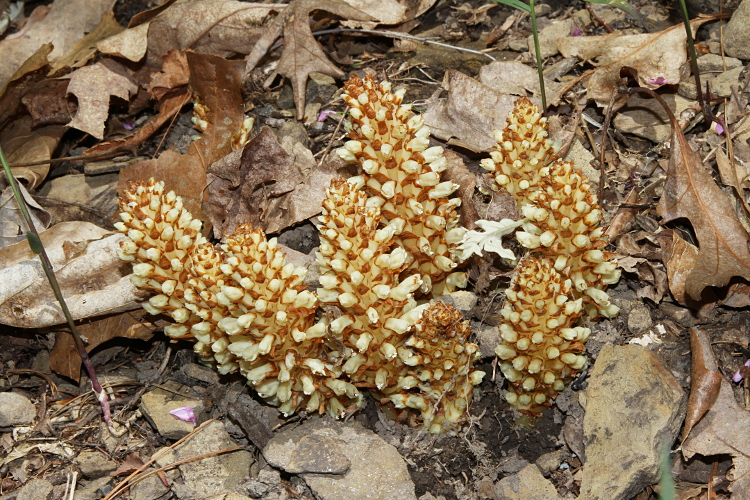
An odd plant that I stumbled across. Turns out is called Squaw Root, or
Cancer Root, or Bear Corn, or... (Conopholis americana).
It has no chlorophyll -- it is a parasite that lives off of oak roots.

Wood Frog (Rana sylvatica) tadpoles in our pool on May 3. I guess
they don't like the sun...
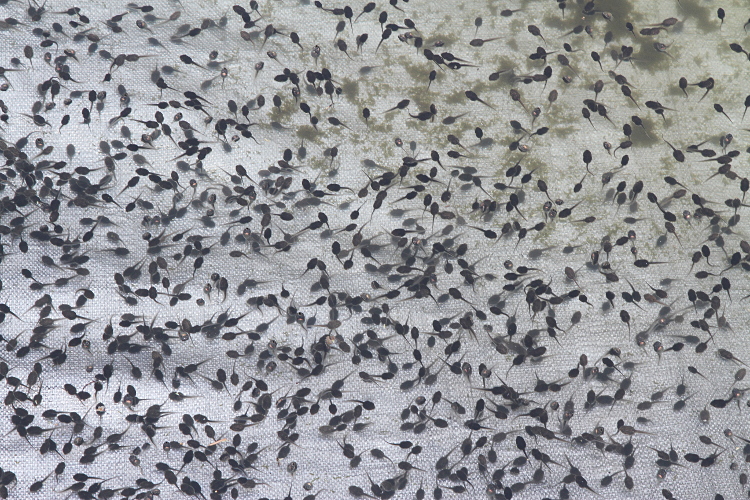
A closer look at the tadpoles.
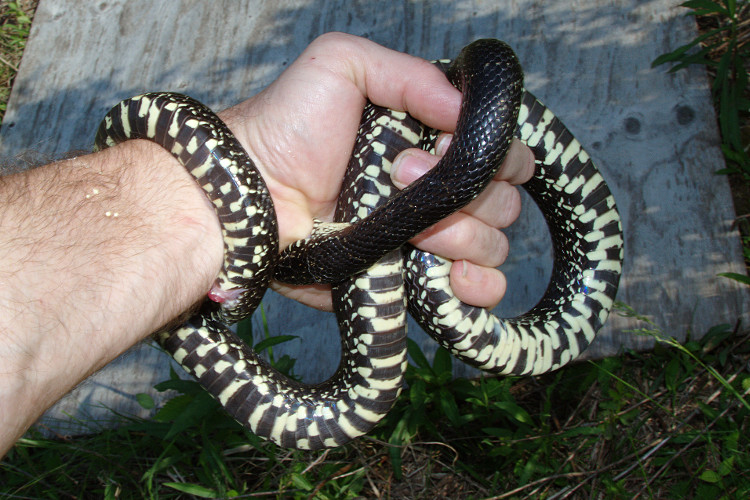
A Black Kingsnake (Lampropeltis getula nigra) and the board it
was found under. A tad bitey.
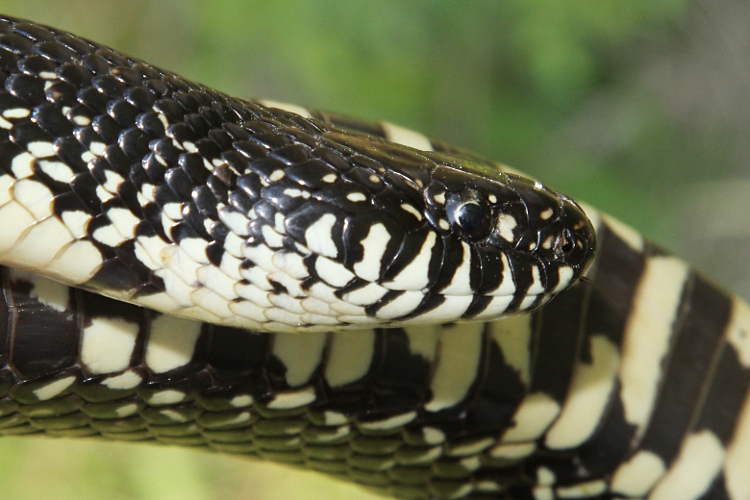
A closer look.
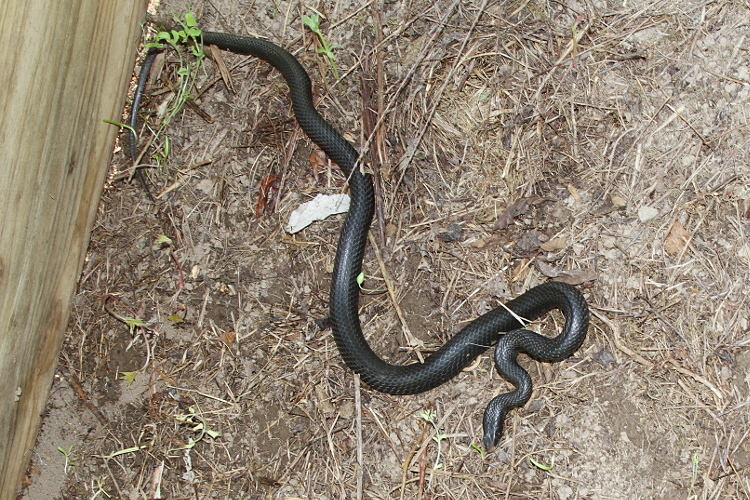
A Black Racer (Coluber constrictor) found under a board.

A Milksnake (Lampropeltis triangulum), as found under a board.

Smooth Earth Snake (Virginia valeriae).

A ventral view of the Smooth Earth Snake.
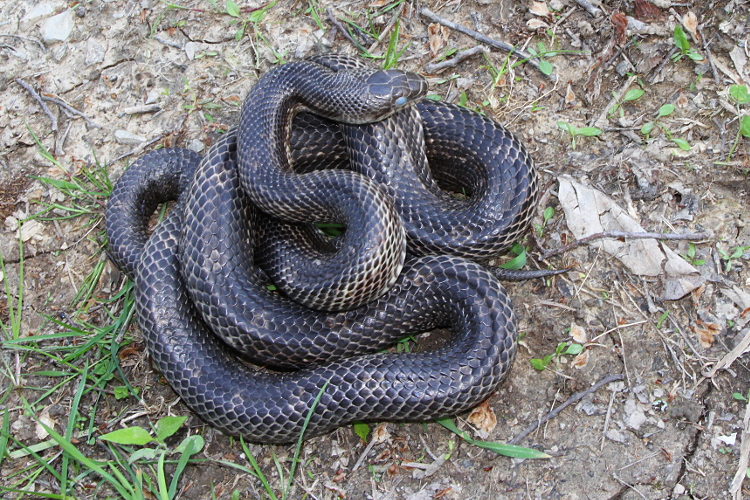
A very large Black Ratsnake (Elaphe obsoleta).
It was in pre-shed condition.
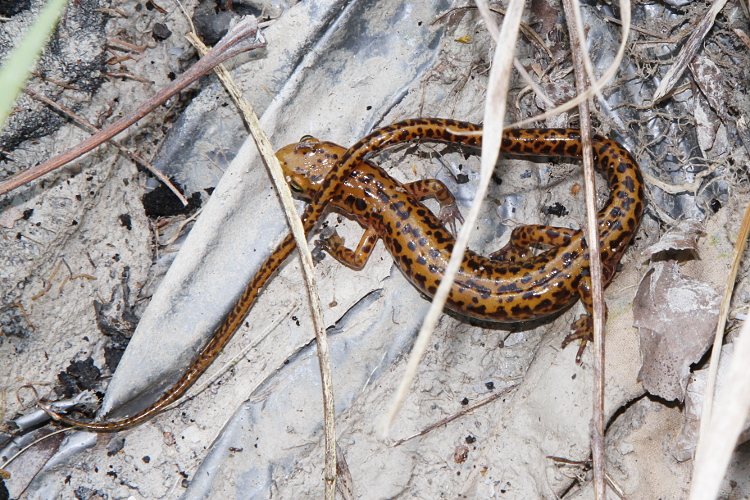
A Long-tailed Salamander (Eurycea longicauda), almost as found
at the bottom of a trash pile.
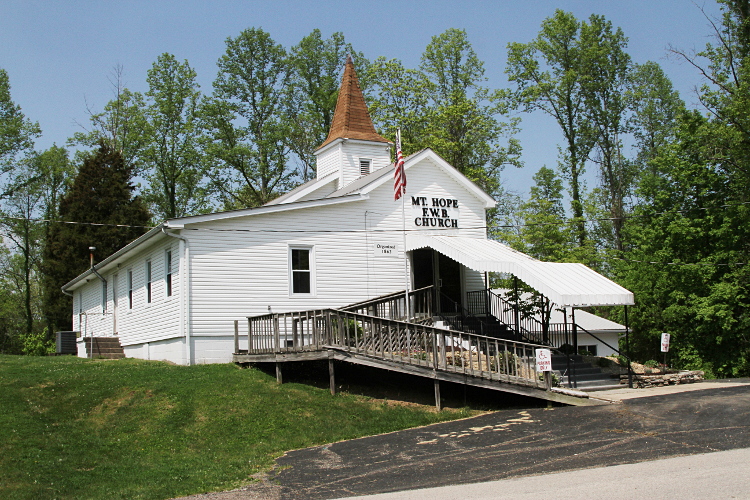
I always like seeing the the old churches in the boonies of southeast Ohio.
This one has a fresh coat of white paint.
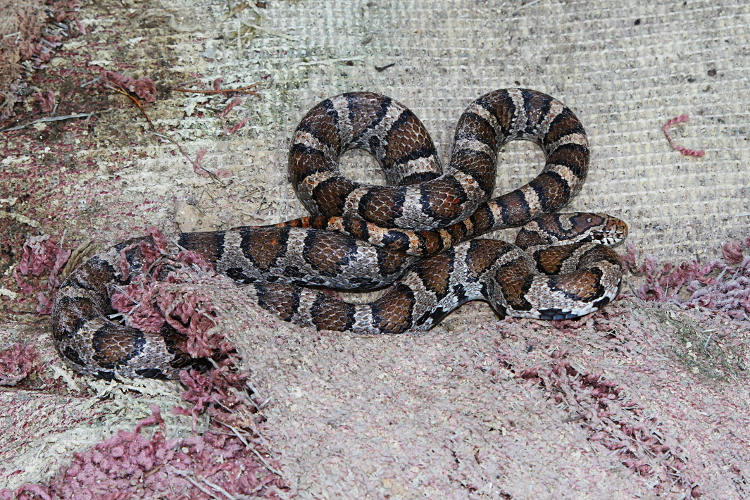
A Milksnake (Lampropeltis triangulum), as found in a pile of carpet.
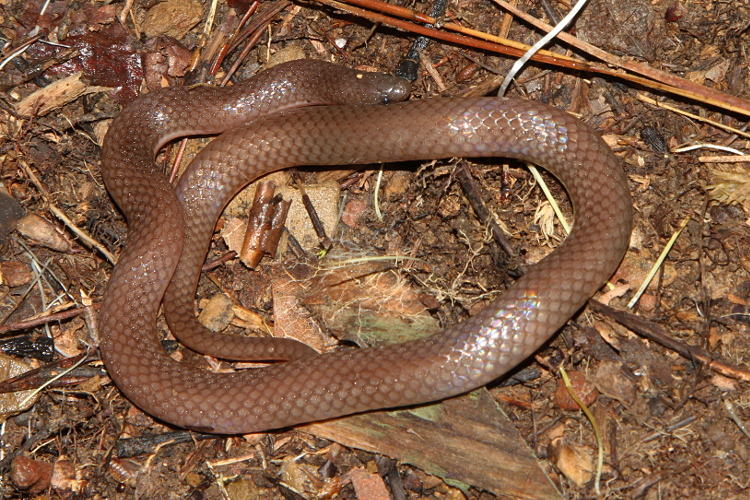
A Worm Snake (Carphophis amoenus), as found under cover.
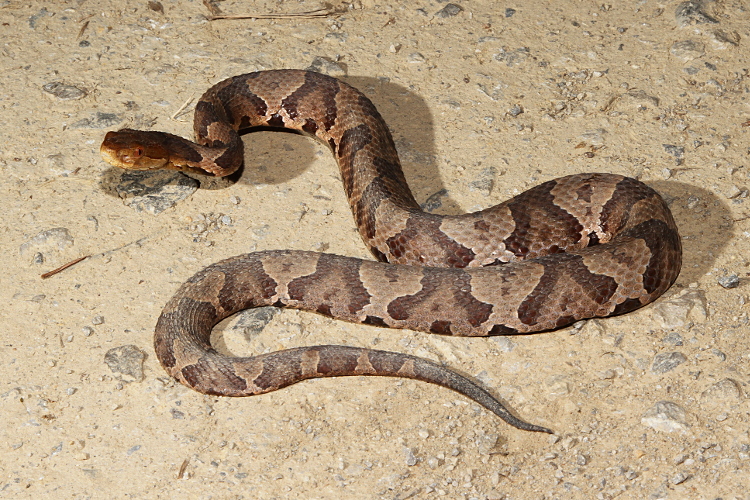
A Copperhead (Agkistrodon contortrix), found on a dirt road after dark.

This little creek flows through downtown Athens. I drive along it every
day on my way to and from work. Today I decided to check it out.
The stream appears to be pretty healthy, although it is unmistakably
urban with numerous chunks of old concrete and some trash.
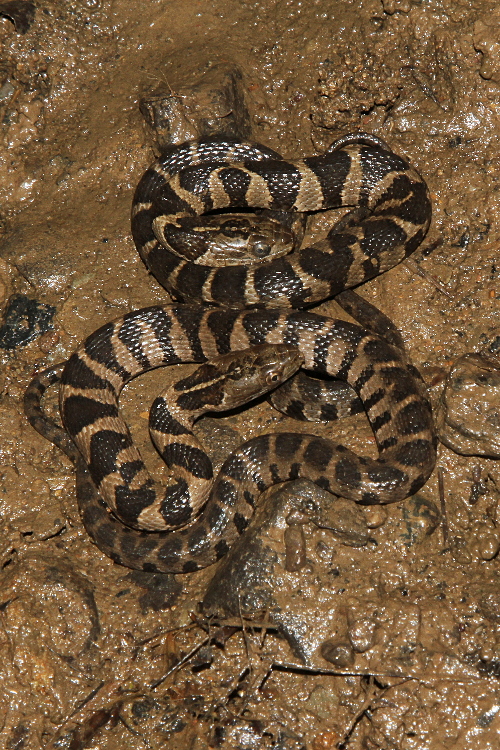
The first critters I found along the creek were these two young
Northern water snakes (Nerodia sipedon).
Shown as found under a rock.
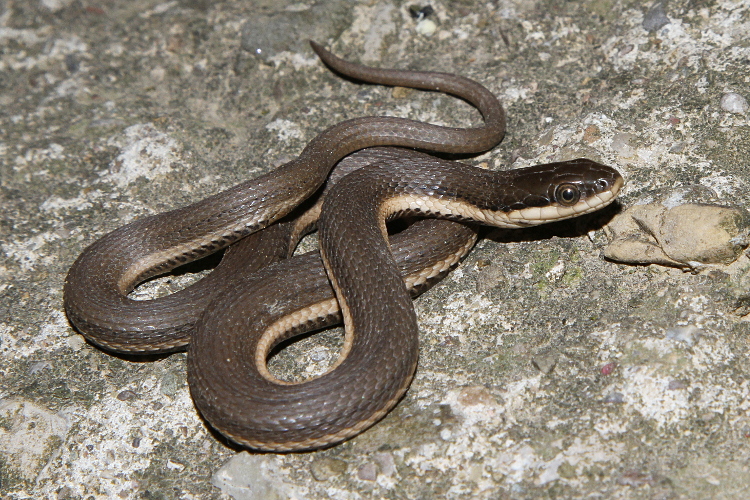
I found this young Queen Snake (Regina septemvittata) under the
black plastic bag in the habitat photo. I do not see this species very often.
I can't believe they've been right here under my nose all of these years.
This is the first one I have seen in Athens County. Note: I am aware there
are places in the eastern part of the County where they are well known.
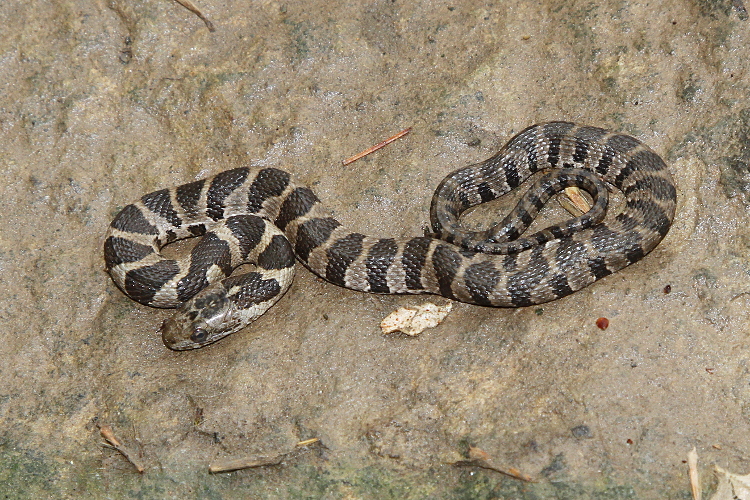
Another young Northern water snake found under a rock. Shown as found.
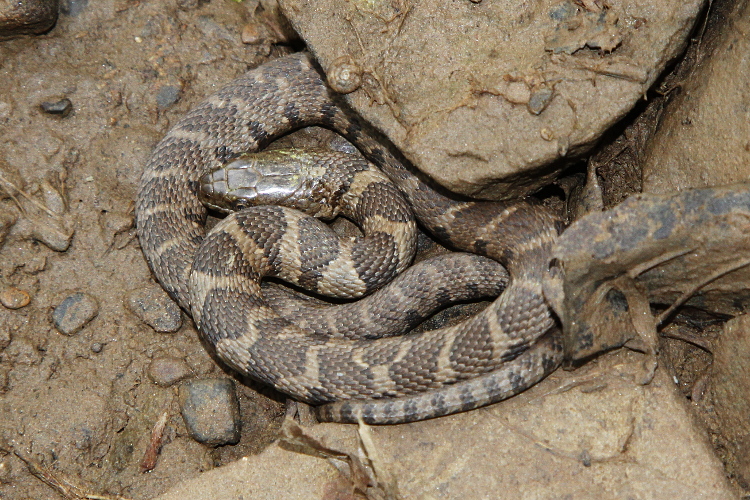
One more young Northern water snake found under a rock. Shown as found.
Now on to elsewhere in southeast Ohio.
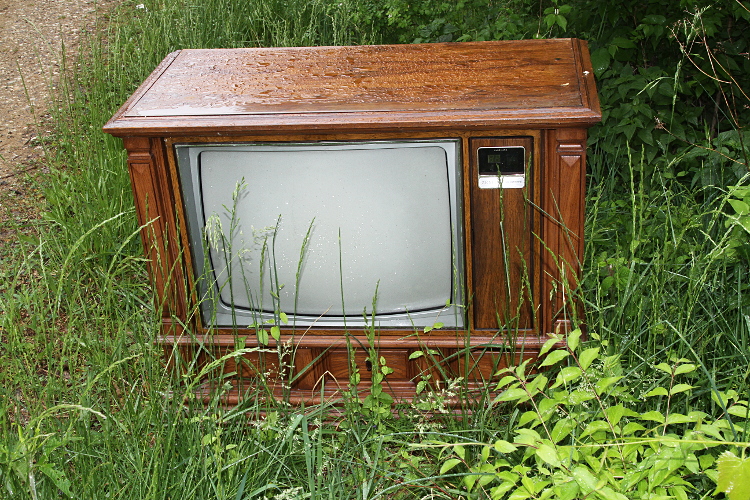
A classic old Zenith found dumped on the side of quiet country road.
This makes me feel old...

A Black Racer (Coluber constrictor), almost as found under a board.
It is in pre-shed condition.
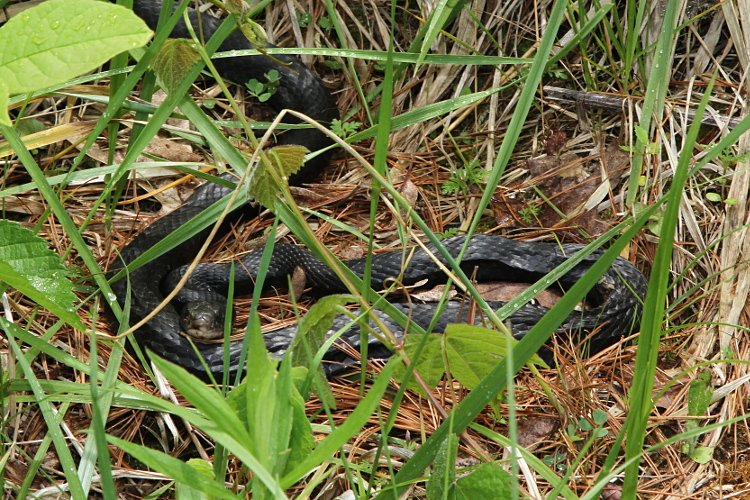
Another Black Racer, as spotted basking in some grass. Perhaps you can
see how the forward 1/3 of the snake looks very bony and/or skinny.
I noticed this right away when I saw it and was wondering if something was
wrong with the snake.
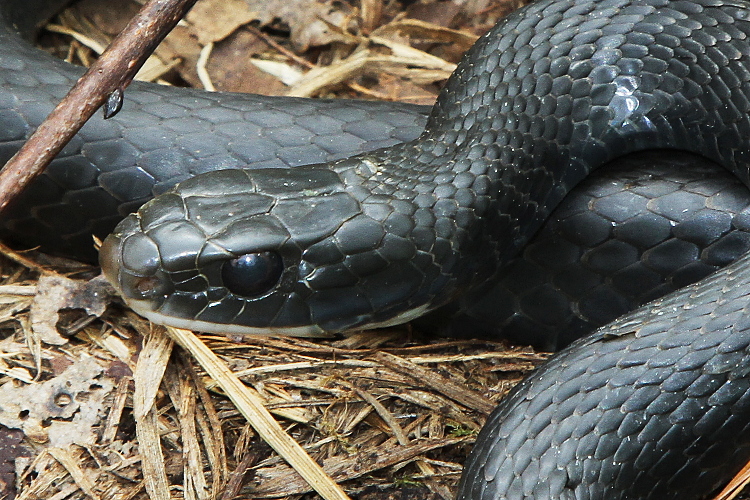
The same Black Racer as in the previous photo, after it re-positioned itself.
Now it looks perfectly normal. In the previous photo, I think the snake must
have just exhaled very deeply.
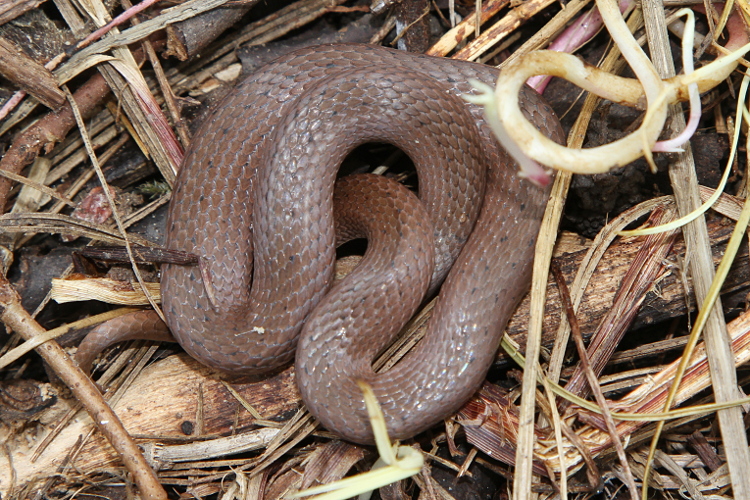
A Smooth Earth Snake (Virginia valeriae), almost as found under cover.
It was camera shy and hid its head.

As I've already mentioned, I find the churches intriguing.
This is an unusual sight, one that is being let go.
You can't tell this from the photo, but the field in the foreground is
plowed and the church is cut off from the road.
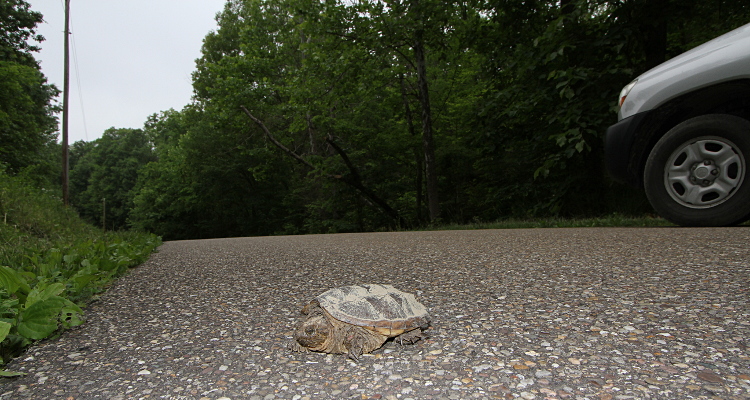
A young Snapping Turtle (Chelydra serpentina), as found
on a road.
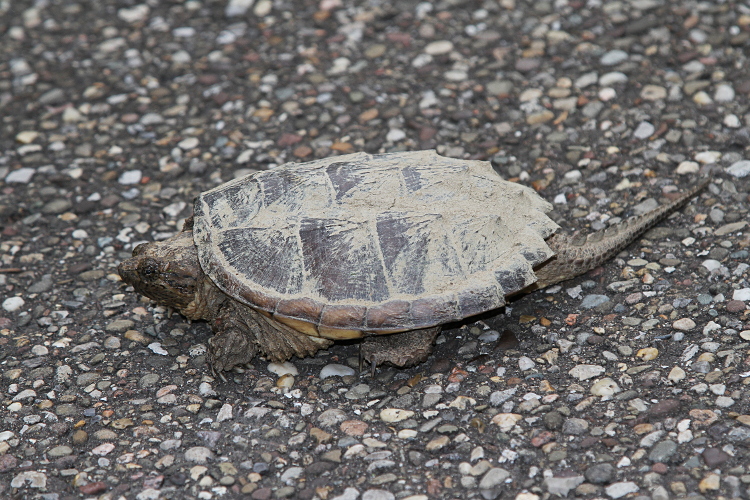
Another look at the Snapper.
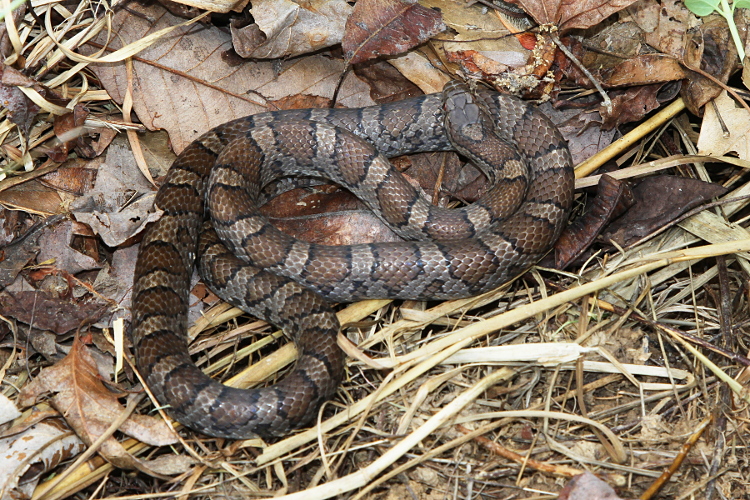
A Milksnake (Lampropeltis triangulum), as found under a board.
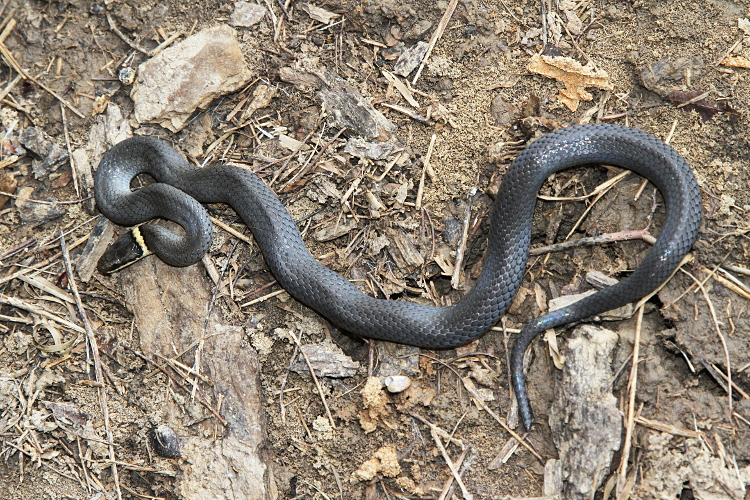
A large Ringneck Snake (Diadophis punctatus), as found under
a board. Probably a gravid female. This species is particularly common
to find under cover in late May and early June.
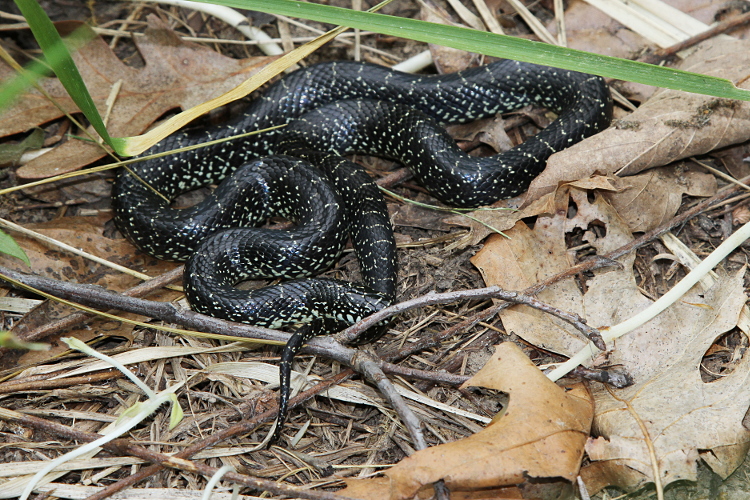
A young Black Kingsnake (Lampropeltis getula nigra), as found
under a board.
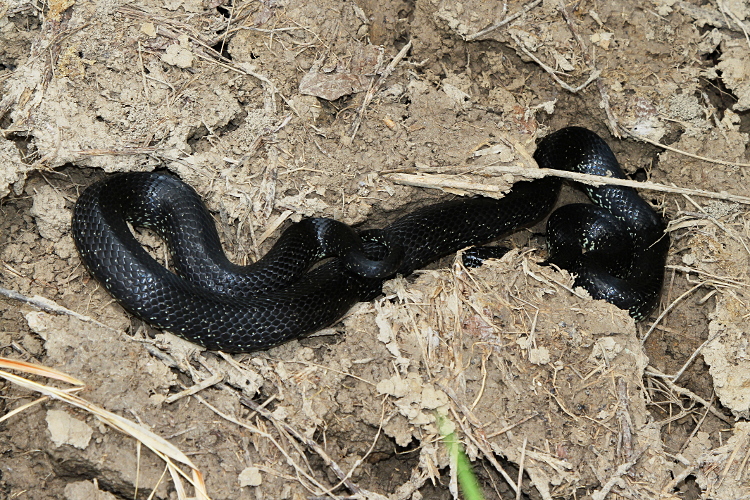
An adult Black Kingsnake (Lampropeltis getula nigra), as found under
a board.
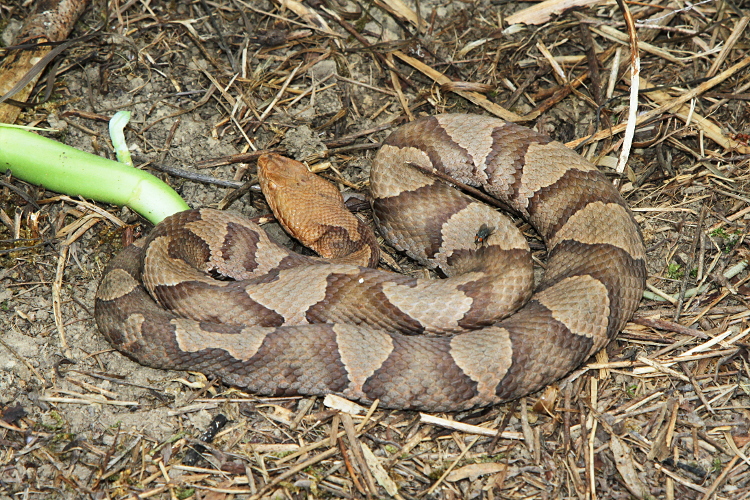
A Copperhead (Agkistrodon contortrix), found under a board.
Shown almost as found -- it lifted its head a bit and a fly decided to
photobomb...

A cool old barn.
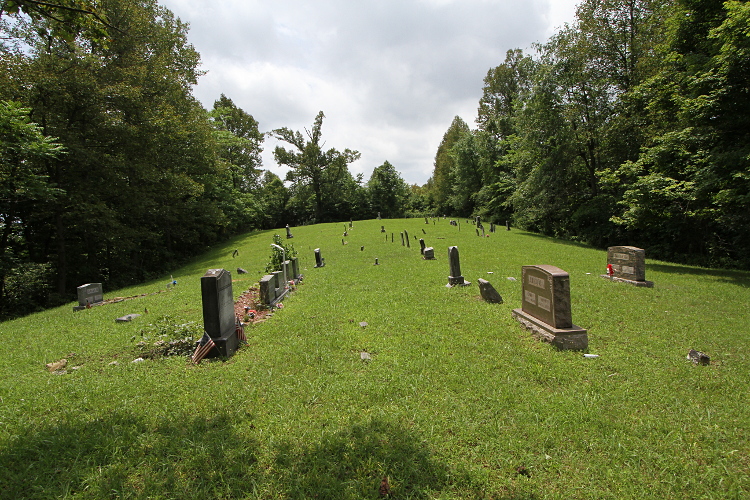
An old cemetery, out in the middle of nowhere. Most of the graves are over
100 years old. These are actually pretty common to run across.
Most of them, like this one, are located on ridge tops. Even in the most
remote areas, nearly all of them are taken care of and the grass is mowed a
few times a year. In a few cases, such as for some of the graves at this site,
the old tombstones have been replaced by modern ones. I've also noticed
that certain types vegetation are common to see at these old cemeteries,
but rare elsewhere in the region. Particularly cedar trees and yucca plants.
I did a little research and it turns out that these are traditional cemetery
plantings, because they are evergreen and require little to no maintenance.
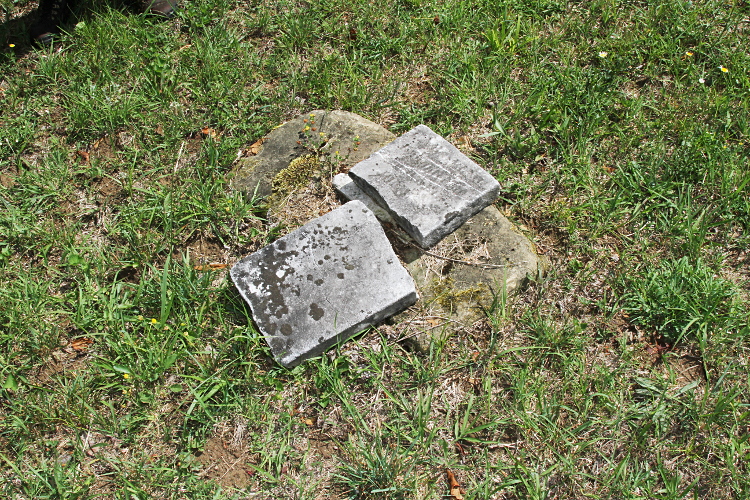
One of the older stones. In this case, I could not resist looking under
the broken piece on the left. A Milksnake was revealed.
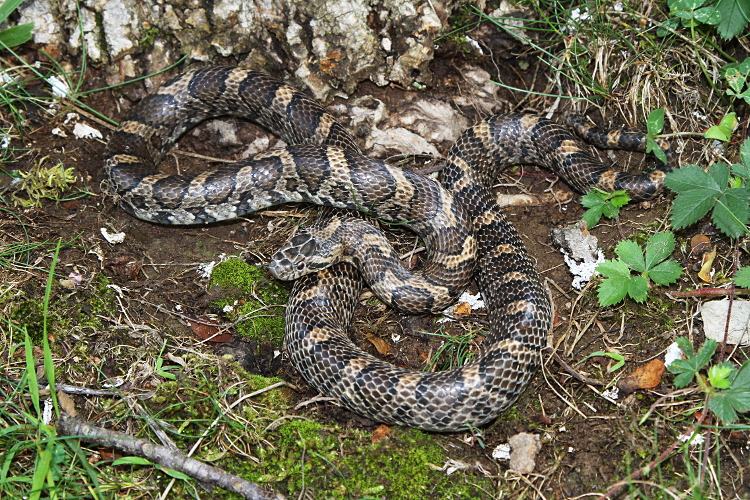
The Milksnake (Lampropeltis triangulum) that was found under a broken
headstone.
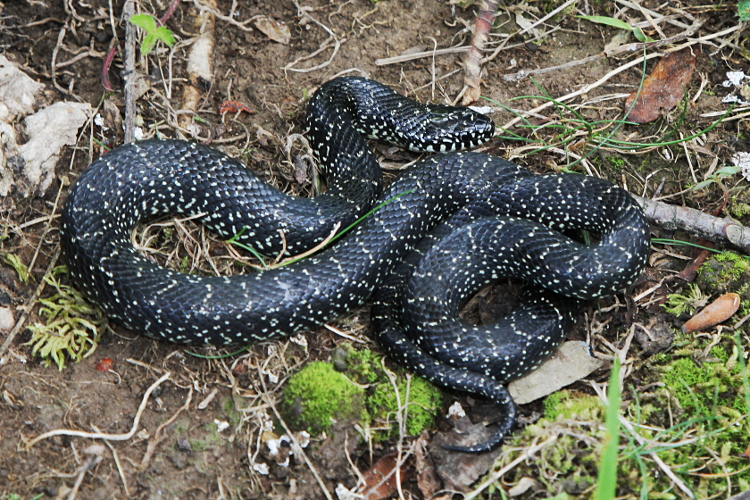
A young Black Kingsnake (Lampropeltis getula nigra) that was found
nearby.
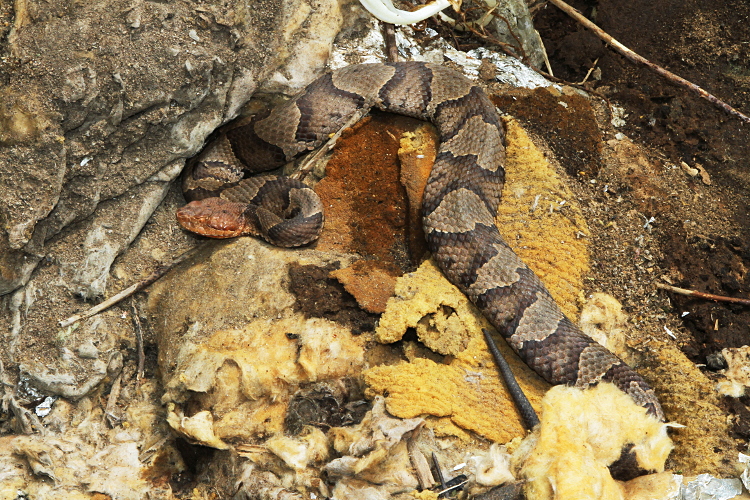
A Copperhead (Agkistrodon contortrix), as revealed when a carpet was
lifted.
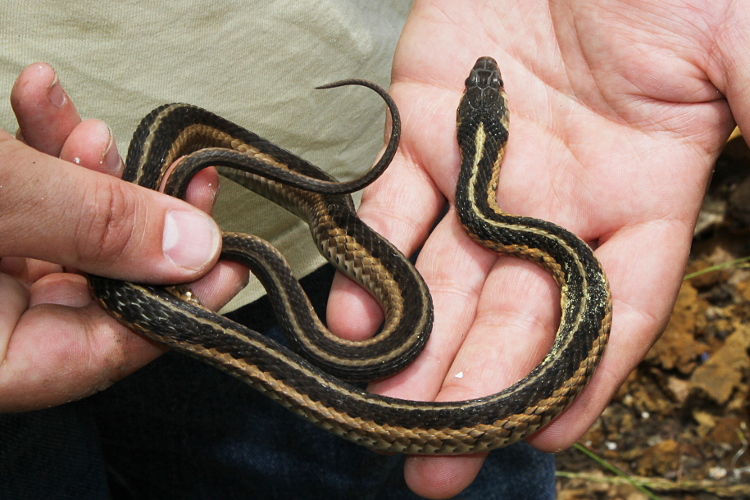
A Common Gartersnake (Thamnophis sirtalis) that was found in the
carpet with the Copperhead. This was the second example of this species
that I saw this year.
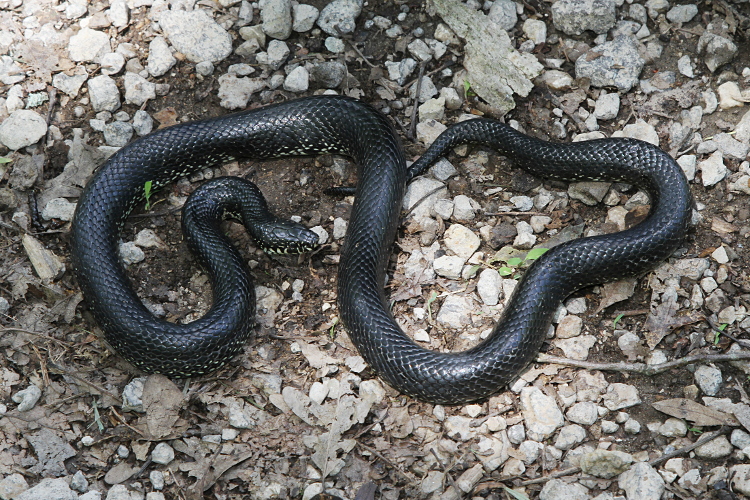
A Black Kingsnake (Lampropeltis getula nigra), found on June 14.
It appeared to be gravid.
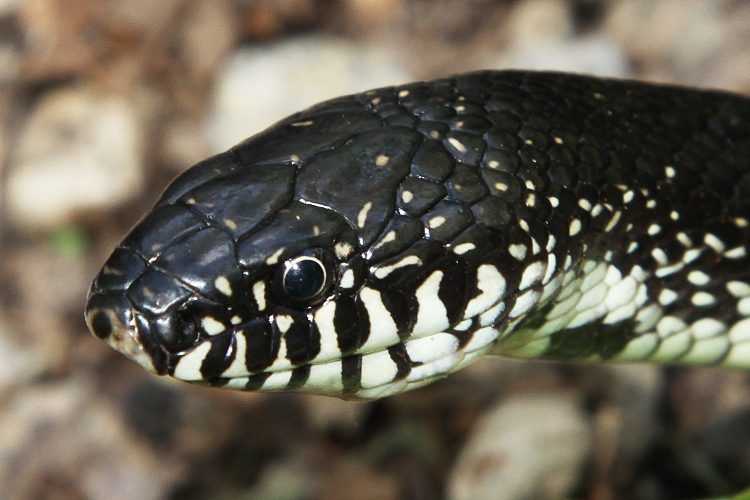
A closer look at the Black Kingsnake.

An attractive Milksnake (Lampropeltis triangulum), also found
June 14. It too appears to be gravid.
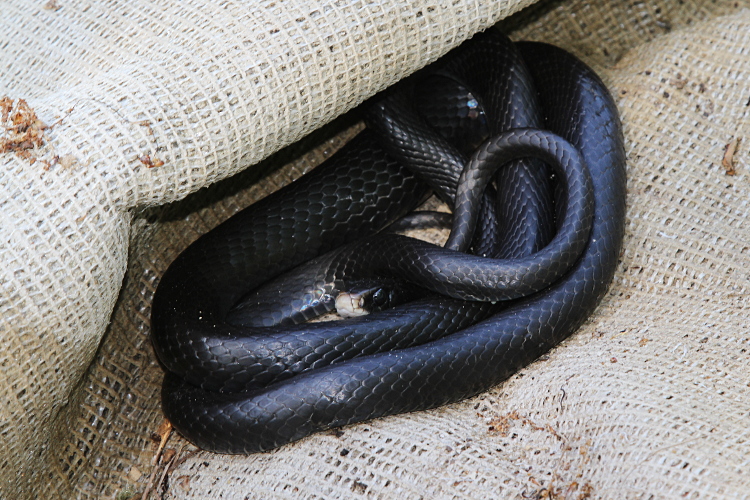
A Black Racer (Coluber constrictor), as found in a folded carpet.
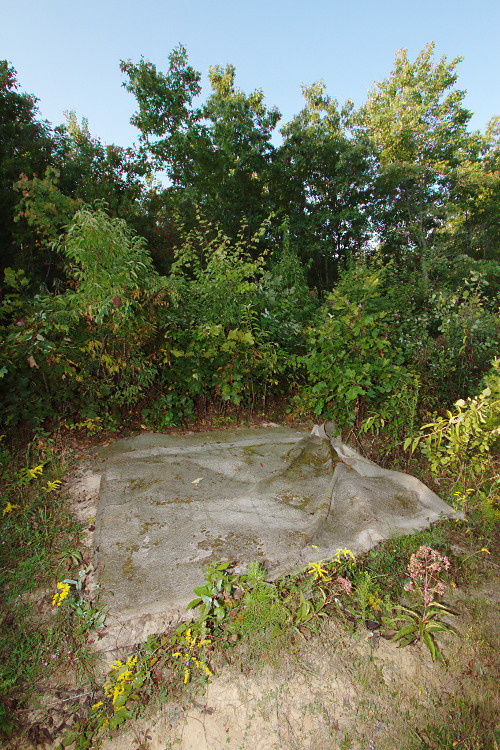
A larger carpet located in a utility right of way on a ridgetop.
Over the past few years, I have seen Black Racers, Black Ratsnakes,
Milksnakes, and Ringneck Snakes under it.
Within a short walk from here, I've seen Black Kingsnakes, Smooth Earth
Snakes, and Dekay's Snakes.
This photo is from later in the season, on September 5. I have included
it as part of an interesting story.
On June 14, I lifted the carpet. At first I did not see anything, but then
I noticed the tail of a black snake coming out of a hole. The scales were
keeled. I also knew instantly that it was not a Black Ratsnake,
Black Racer, or Black Kingsnake, which are snakes that I see commonly.
I even considered the possibility of a melanistic Common Garter Snake, because
I had seen photos of them posted on the internet recently. Just as I realized
what species it must be, the snake made a loud hiss, and its head popped
up out of the ground.
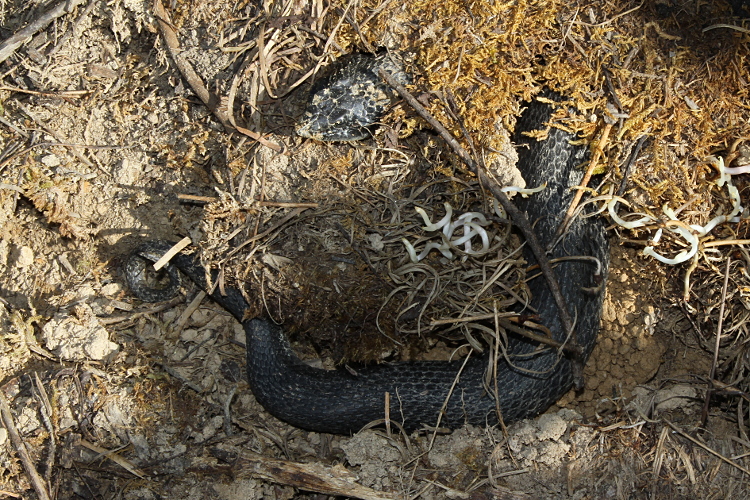
An Eastern Hog-nosed Snake (Heterodon platirhinos)!
This is the all-black (melanistic) color phase.
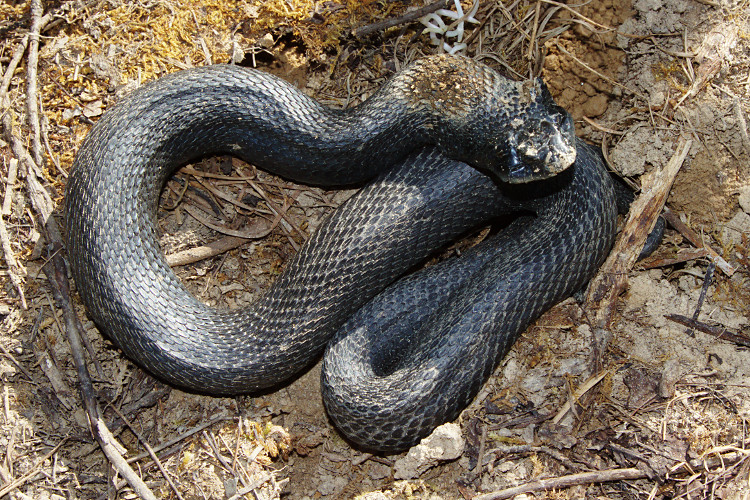
I took a couple more photos, and otherwise left the snake alone.
I returned the carpet to its original state.
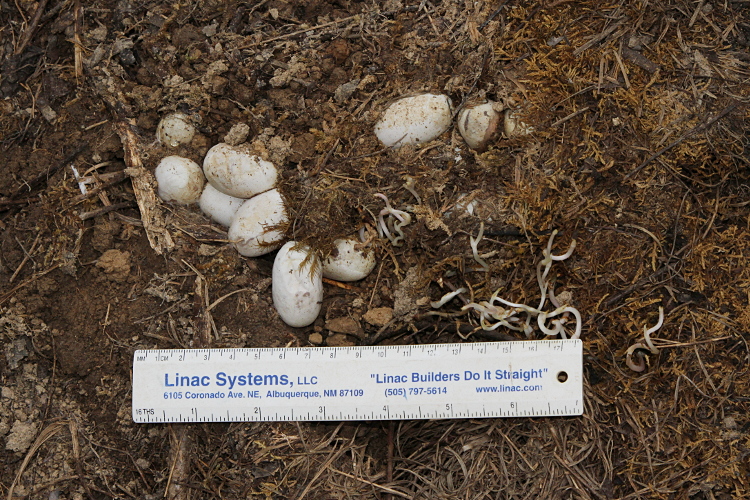
I returned to the site on July 5 and found that snake eggs had been
laid in the tunnel the Hog-nosed Snake was in.
Although it is hard to say for sure, my impression was that that there were
several more eggs than one can see in photo, perhaps a lot more eggs,
farther underground.

I checked in on the eggs again on August 6. They did not appear to be doing
well. The upper layer were clearly dead and deflated. The nest was also
crawling with ants.
I removed 7 of the dead eggs. It was not clear to me what happened.
The deflated eggs shells had numerous small holes in them. Perhaps a predator?
Or maybe the they got too hot (the carpet is in full sun)?
I also took 2 eggs that were located just below dead eggs home.
I put them in a container with moist perlite, something Roxanne has laying
around for making potting soil.
I must admit that I did not have a great deal of confidence in these eggs.
They felt a bit mushy to me and they were right next to the dead eggs.
But I am not an expert on these matters.
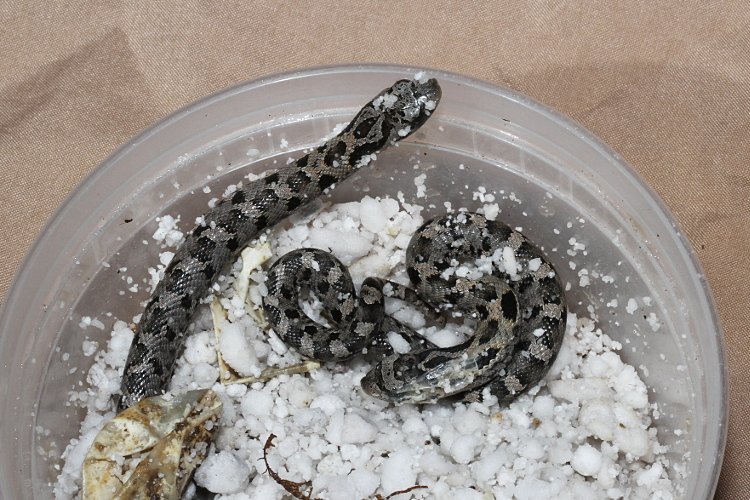
On August 31, both eggs hatched! A couple of days later, they shed their
skin. You can see part of the shed on the snake on the right.
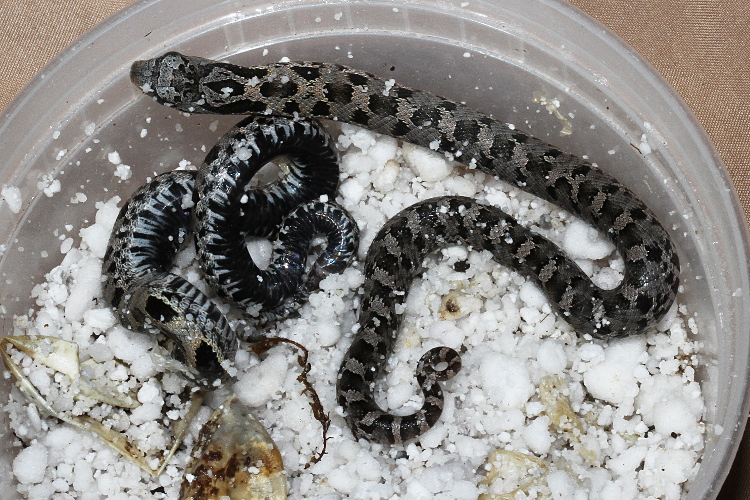
Another look. They both had black bellies. They were weighed and measured:
| snake |
#1 |
#2 |
| weight |
6.55 grams |
5.94 grams |
| total length |
207 mm |
205 mm |
| snout-vent length |
177 mm |
177 mm |
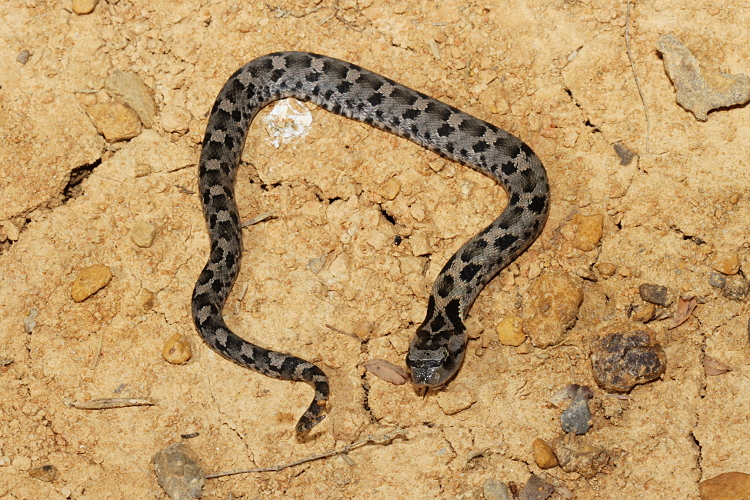
This is #2, which refused to sit still, unless it was playing dead.
It never hissed or spread its neck.
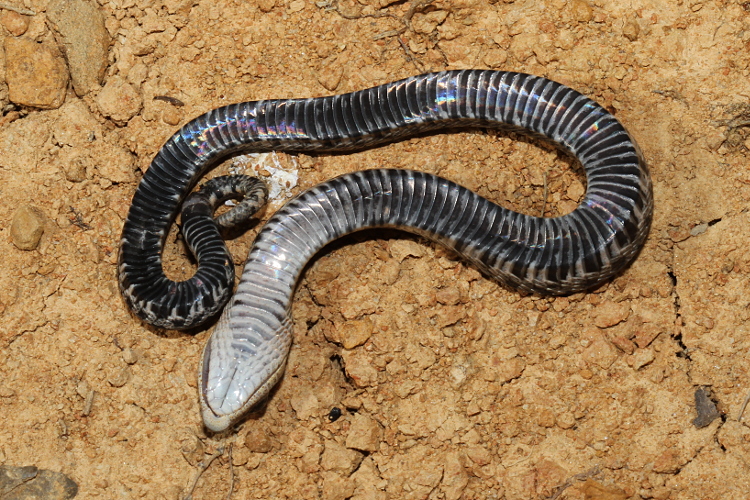
#2, playing dead.
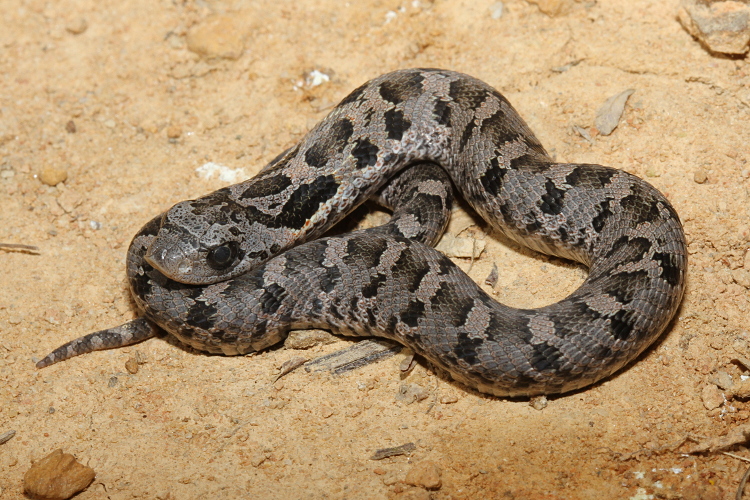
This is #1, which never played dead, but often hissed and spread its neck.
It did eventually sit still for a photograph.
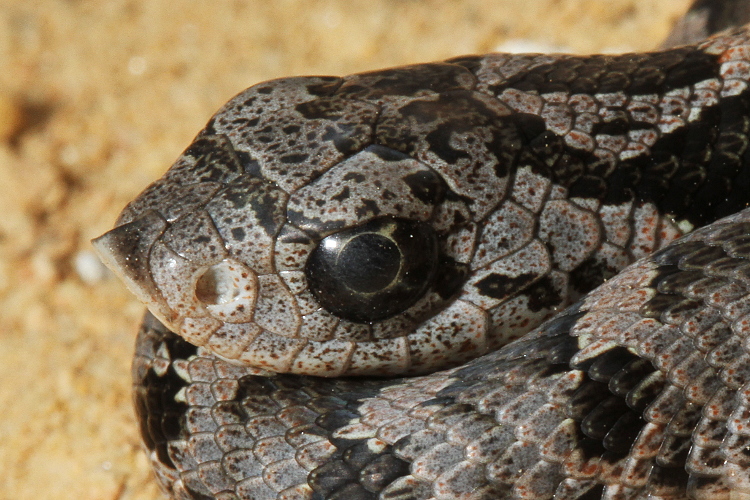
A closer look at #1. My what big eyes you have.
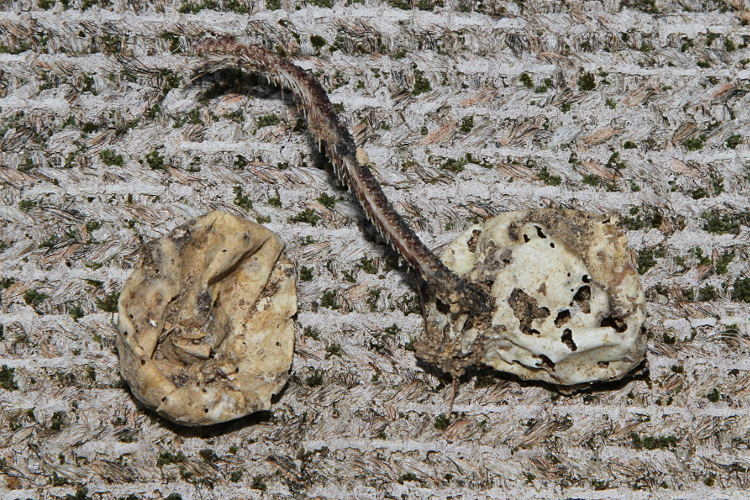
I returned the two babies to carpet site a few days after they hatched.
I could not tell if any of the other eggs had successfully hatched.
Some clearly had not, such as the two shown above.
That's the end of that story. I am now returning to chronological order.
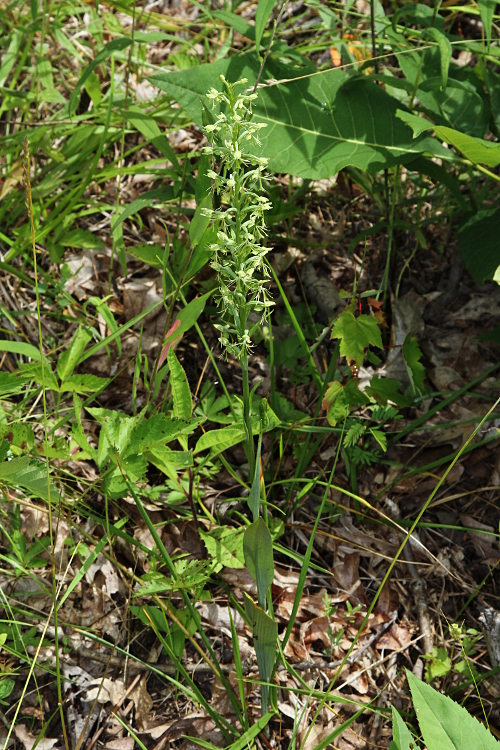
Green-Fringed Orchid (Platanthera lacera), seen on June 24.
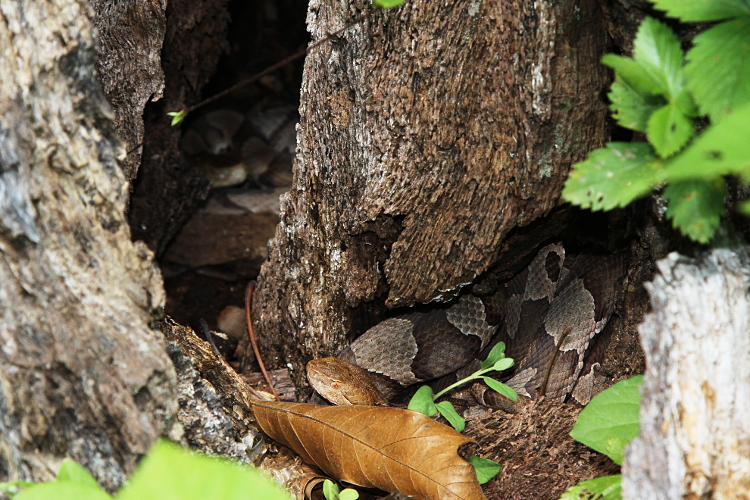
A pair of Copperheads (Agkistrodon contortrix) that were seen hanging out at
a hollow stump. Shown as found. It is very likely that both are gravid.
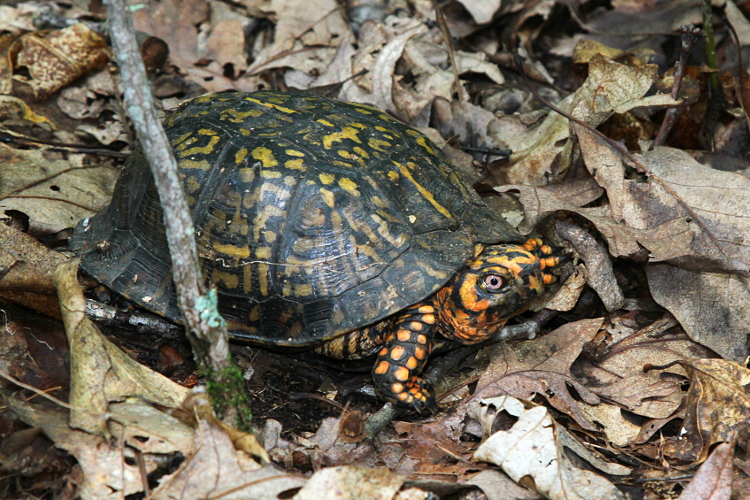
An Eastern Box Turtle (Terrapene carolina), shown as found.

Some snake eggs observed under a board on July 1. I believe these
are Black Racer (Coluber constrictor) eggs.

A Milksnake (Lampropeltis triangulum), found under the board in
the background.
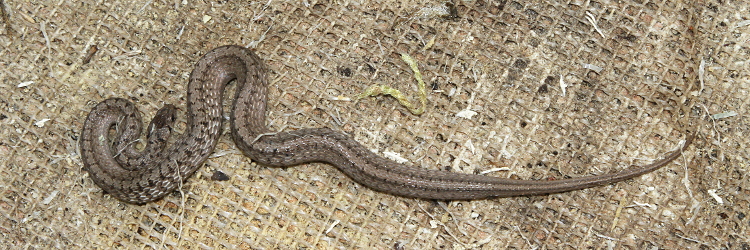
A Dekay's Snake (Storeria dekayi), as found between layers of carpet.
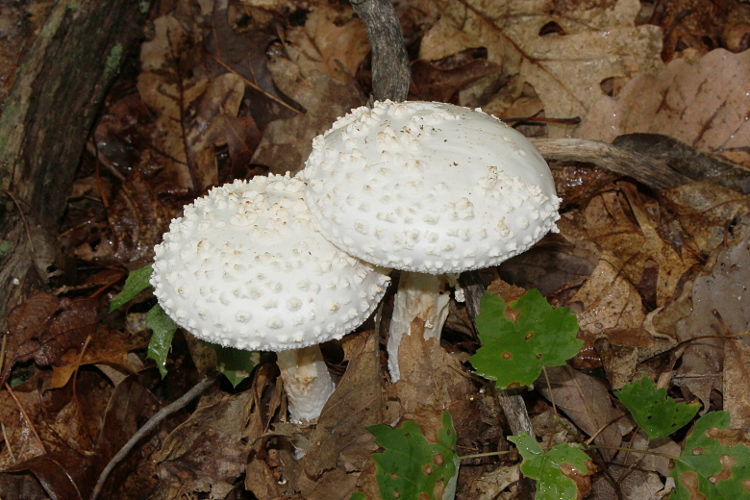
June and much of July were very wet this year, which led to all sorts of
mushrooms popping up in the forest. My friend Jim has helped
me with identification. These are Amanita.
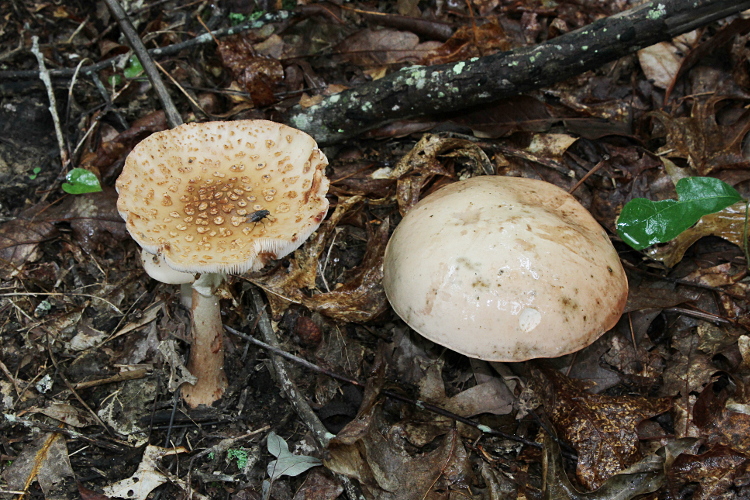
More mushrooms (Amanita on the left and
Boletus on the right). And a fly.
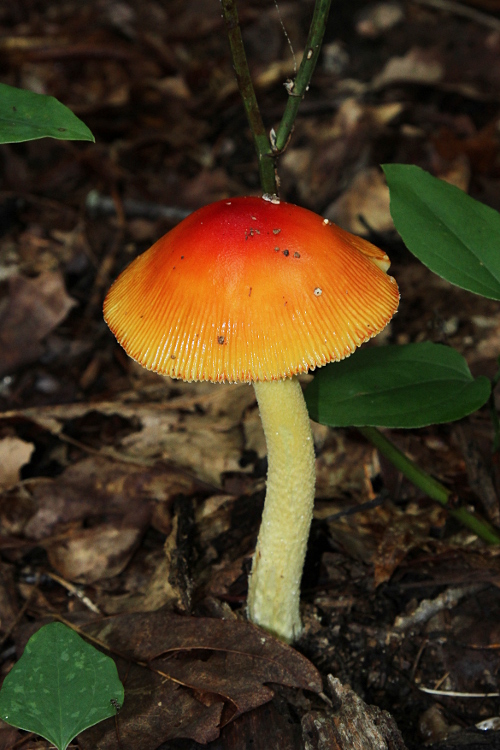
This one didn't even look real. It is a Waxy Cap (Hygorphorus).
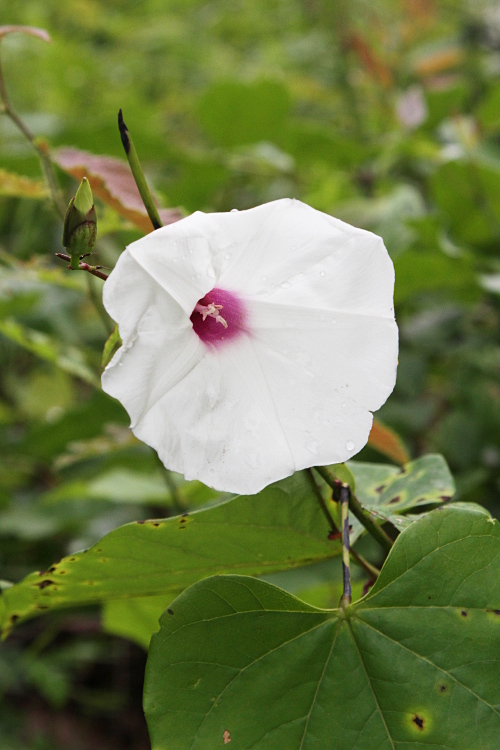
Wild Potato-vine (Ipomoea pandurata).
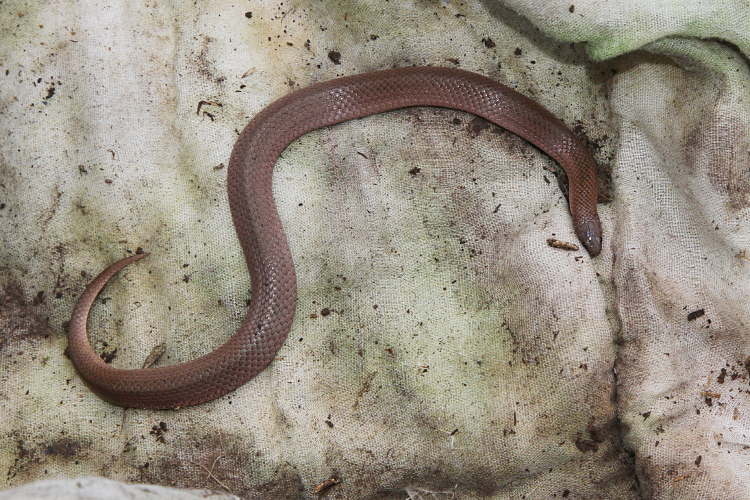
A Smooth Earth Snake (Virginia valeriae), as found in a discarded
blanket. After I took this photo, I checked under the blanket and there was
an adult milksnake.
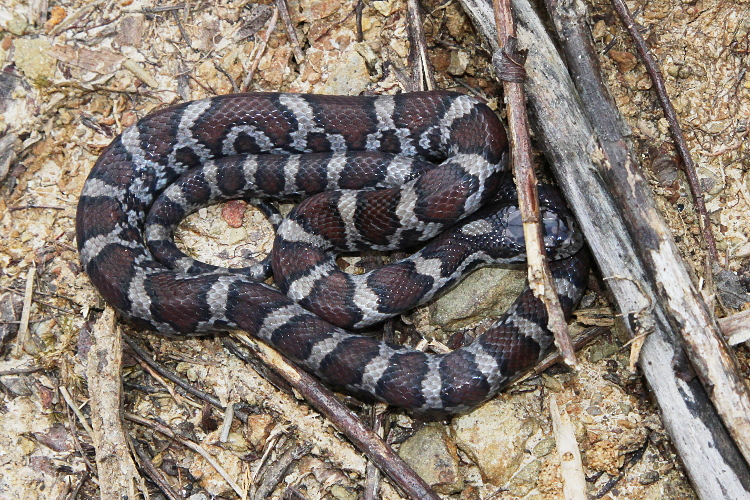
A young Milksnake (Lampropeltis triangulum), as found under cover.
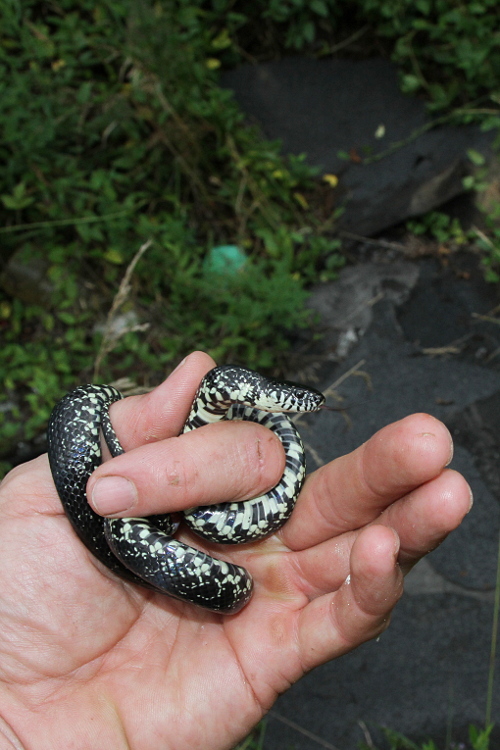
A young Black Kingsnake (Lampropeltis getula nigra) that was found
under the tar shingles in the background.
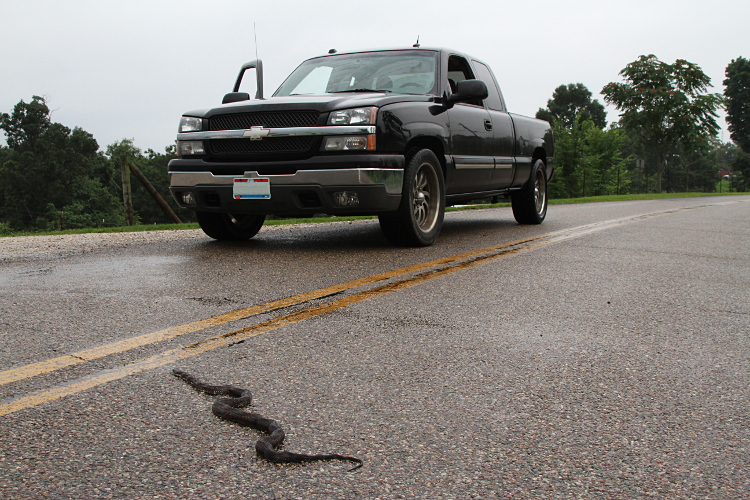
A Black Ratsnake (Elaphe obsoleta), as found on the road on
a drizzly day.
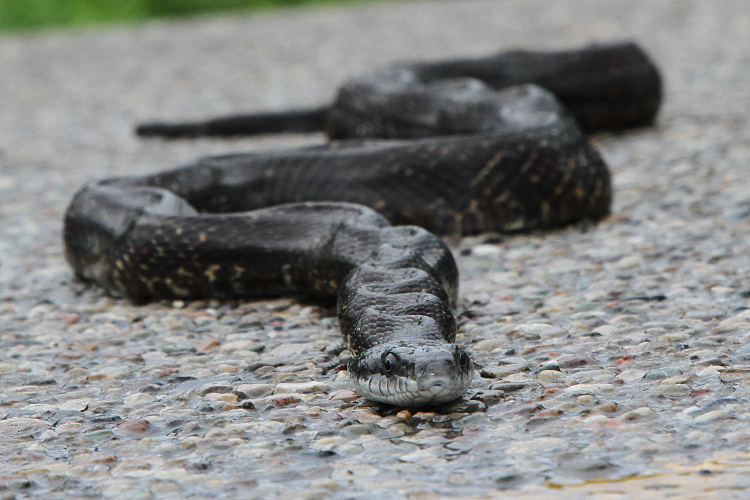
A closer look at the Black Ratsnake.
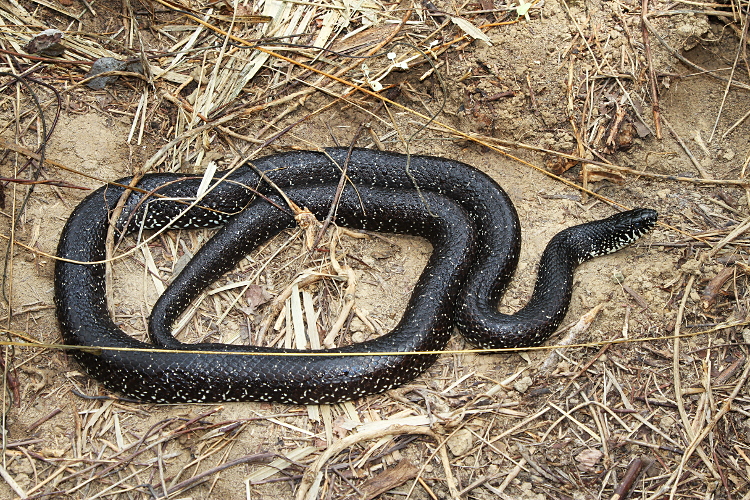
A large Black Kingsnake (Lampropeltis getula nigra), as found under
under a board.
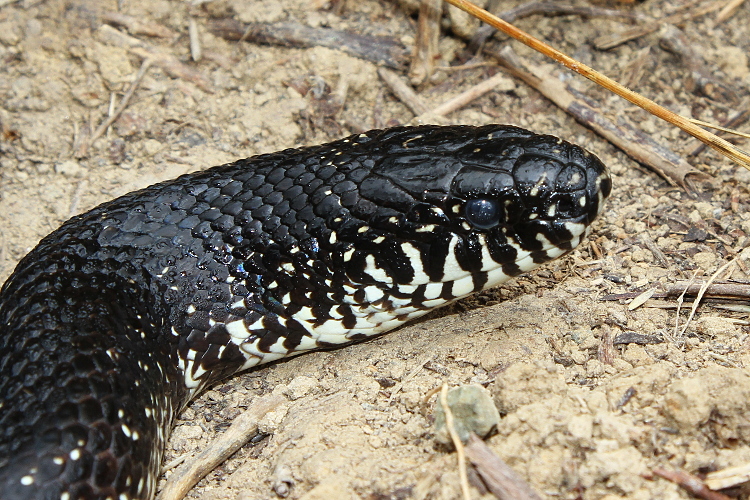
A closer look at the Black Kingsnake. In the morning, it is not unusual to
find condensation beaded up on them. Their shiny skin (aka Lampropeltis)
seems to be particularly effective at causing water to bead up.
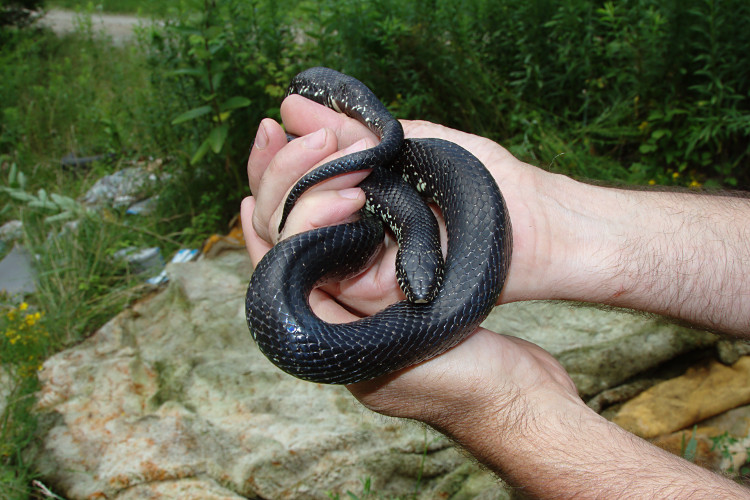
Another Black Kingsnake that was found under the carpet in the background.
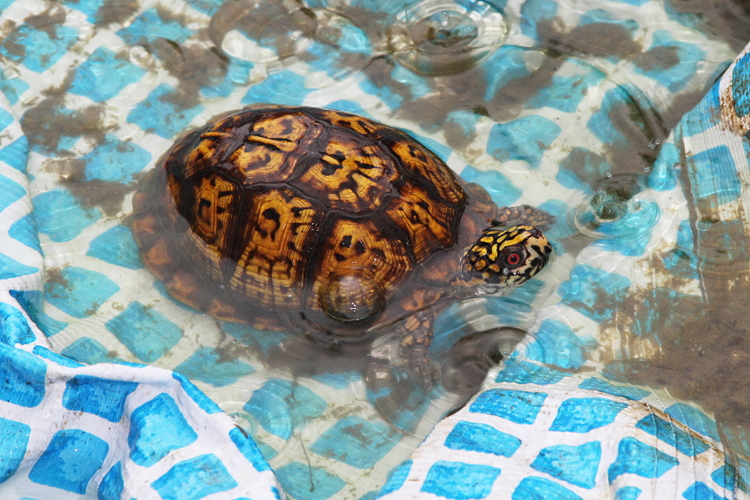
An Eastern Box Turtle (Terrapene carolina) going for a dip in the pool.
Shown as found. By the way, it really is a pool -- a discarded kiddie pool
that has collected rainwater.
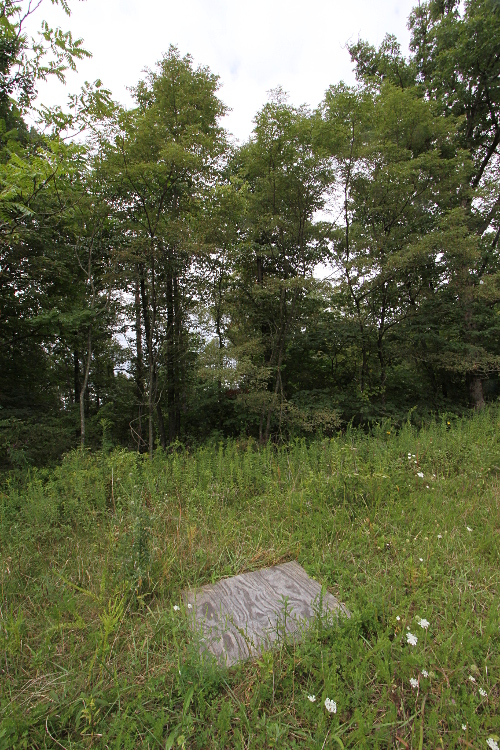
A board situated on a ridgetop clearing. The only snake species that I have
ever seen here is a Black Kingsnake. This photo is from later in the season,
on August 26, and I am again including it to start a snake egg story.
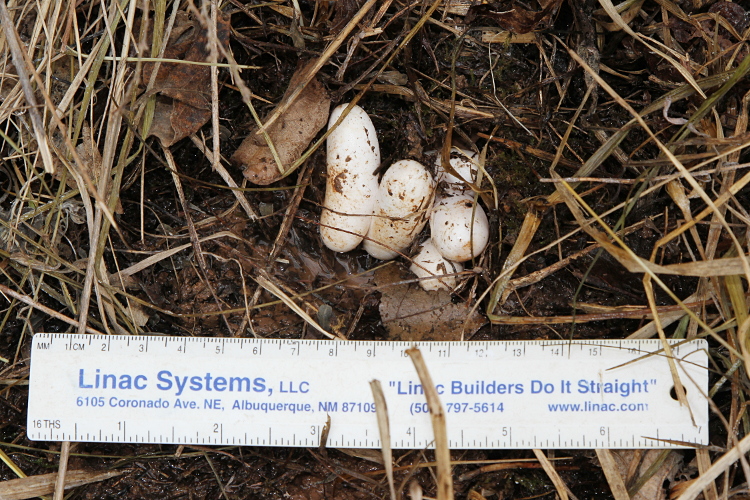
On July 10, this clutch of 5 snake eggs were seen under the board.
The eggs were not there on June 14. The eggs were between 35 and 40 mm long,
between 13 and 15 mm in diameter at the largest point, and were stuck together
in a clump. I did a little research and concluded that there was a good
chance that they were Rough Green Snake eggs.
A few days later, I was in the area again, and I brought them home.
My plan was to hatch them out and see what they were.

Finally, on September 15, the eggs started to hatch. It turns out that
they were Milksnake (Lampropeltis triangulum) eggs.
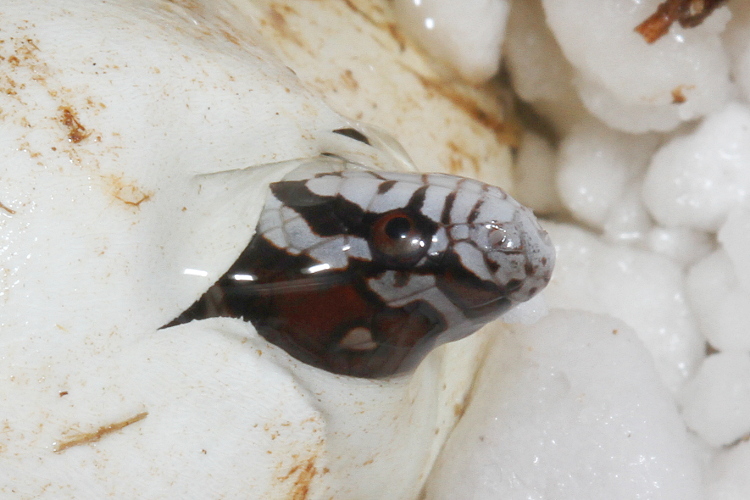
This one entered the world upside down.
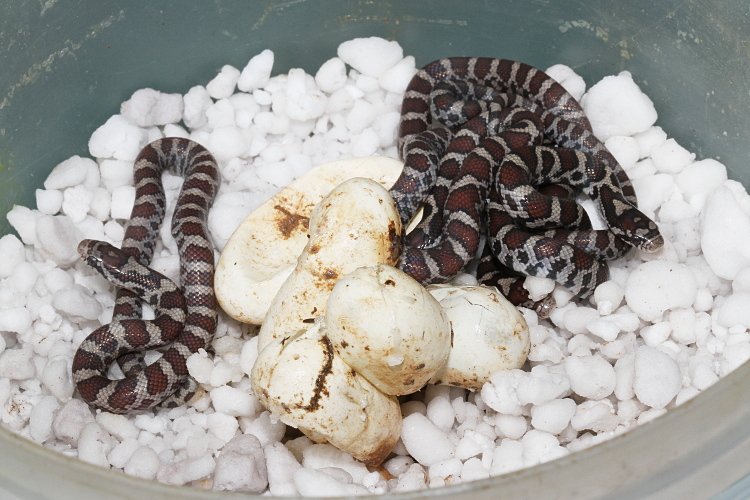
Four out of five had hatched out by September 18.
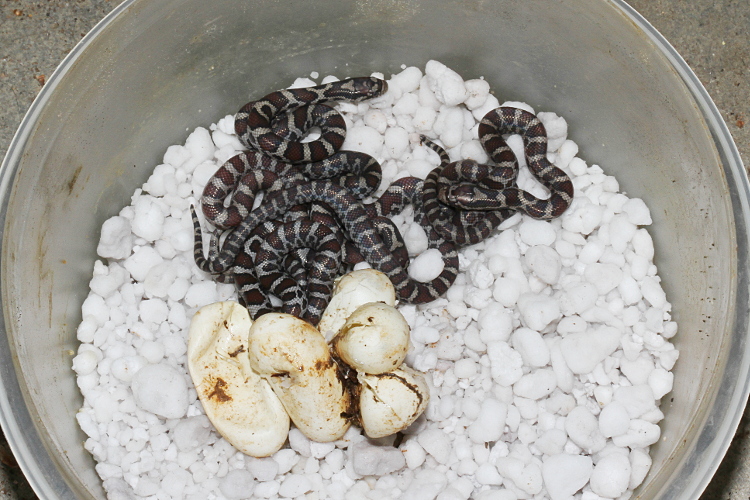
Finally, on September 19, the last egg hatched. They were released
at their point of origin. But before doing so, measurements were taken:
| snake |
#1 |
#2 |
#3 |
#4 |
#5 |
| weight |
3.62 grams |
3.81 grams |
3.69 grams |
3.80 grams |
3.86 grams |
| total length |
194 mm |
215 mm |
194 mm |
202 mm |
210 mm |
| snout-vent length |
170 mm |
187 mm |
169 mm |
178 mm |
182 mm |
That's the end of the story, so I'm now returning to chronological order.
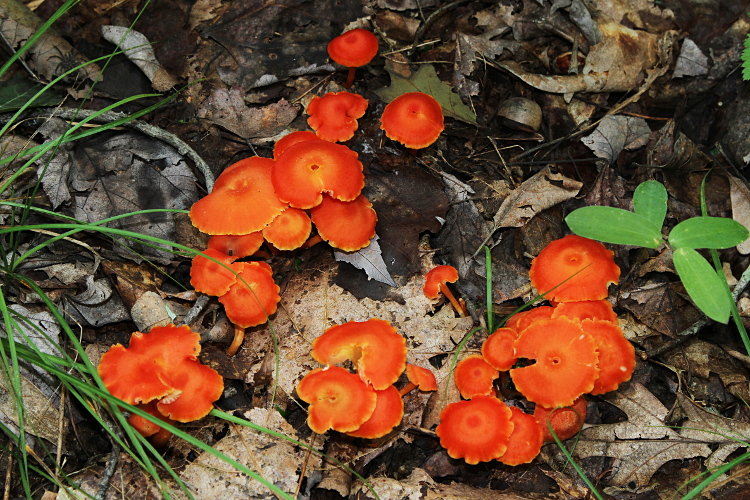
Some colorful mushrooms observed on July 12.
They are Waxy Caps (Hygorphorus).
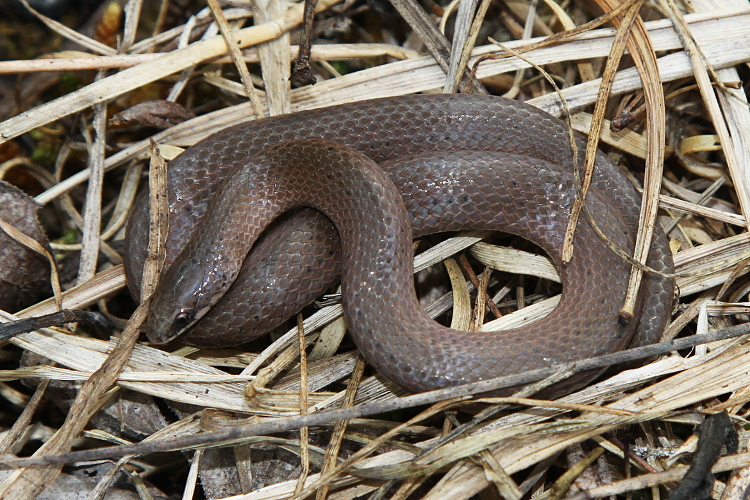
A Smooth Earth Snake (Virginia valeriae), as found under cover.

Wood Froglets aka metamorphs (Rana sylvatica) hanging out at the
shoreline on the tarp that covers our pool on August 2.
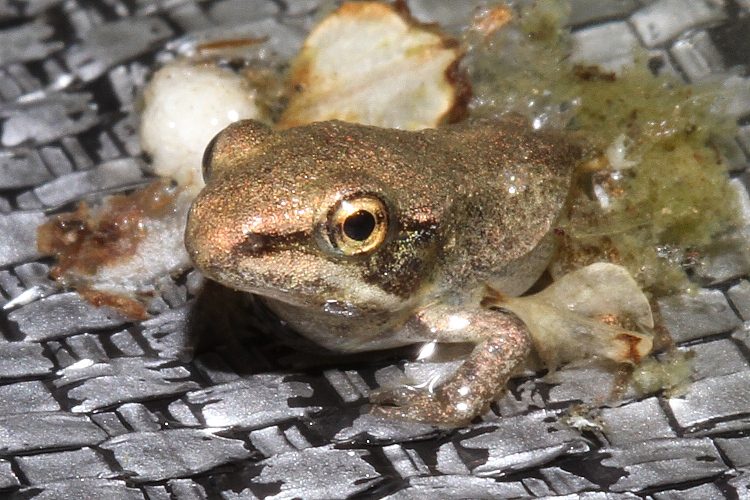
A closer look at one of them.
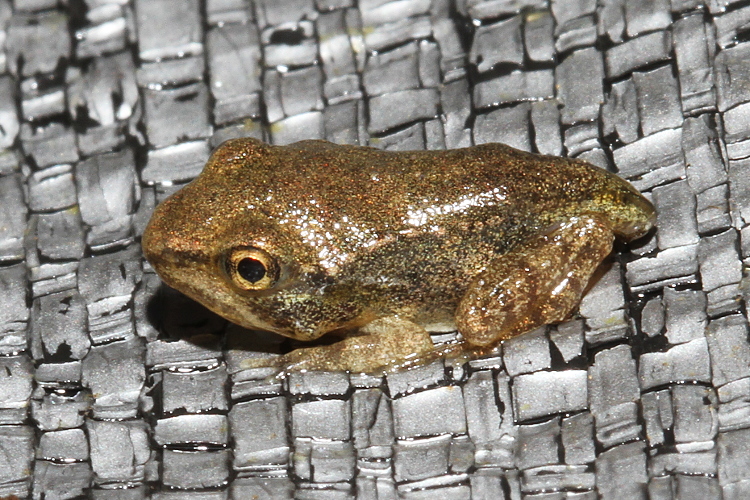
Another Wood Froglet.
There is an interesting story to tell about the frogs and toads and our pool.
Every spring since we moved here, 2002-2014, the American Toads
(Bufo americanus) have bred prolifically in the water that collects in
the tarp that covers our swimming pool during the winter.
We generally leave the tarp in place until most of the
tadpoles have transformed.
Starting in March 2012, we have also had Wood Frogs. In 2012-14, the number
of Wood Frogs breeding was modest, with 4 or 5 egg masses being observed. This
year, however, there were around 20 egg masses. I figure this is because
they are becoming more established in the area and those frogs born in our
''ephemeral pool'' are returning to breed.
This year the Wood Frog activity on our pool started on the night of
March 13/14 and calling continued through April 3.
American Toad calling started April 3 and continued through April 10.
During the day on April 7, I observed several strings of American Toad eggs and
also noticed that the Wood Frog eggs were hatching.
On April 12, I noticed that all of the toad eggs were gone.
By this time there was a very high density of Wood Frog tadpoles.
I was wondering if Wood Frog tadpoles eat toad eggs.
It turns out that they do, and there is a very interesting paper on the
subject: Breeding Habitat Segregation of Wood Frogs and American Toads:
The Role of Interspecific Tadpole Predation and Adult Choice,
James W. Petranka, Mark E. Hopey, Barton T. Jennings, Shannon D. Baird,
and Sarah, J. Boone, Copeia 1994(3), pages 691-697.
Not only do the Wood Frog tadpoles eat American Toad eggs, but if there are
a lot of Wood Frog tadpoles around, the American Toads will not breed there.
Sure enough, no toads were heard calling from our pool after the night of
April 9/10 -- in spite of many nights with ideal conditions where
they could be heard calling in the distance. There was zero successful
American Toad reproduction in our pool this year.
So the Wood Frogs have displaced the American Toads from our pool, which
is pretty remarkable considering how abundant the American Toads have been
in the past. In previous years, the Wood Frog transformed between the
last week in May and the first week in June.
However, this year they did not transform until the first week of August.
Although this summer was cooler than most, I do not believe that is the
reason for the slow transformation. I suspect there were so many tadpoles
that they were limited by food or other resources.
I am curious to see what happens next year.
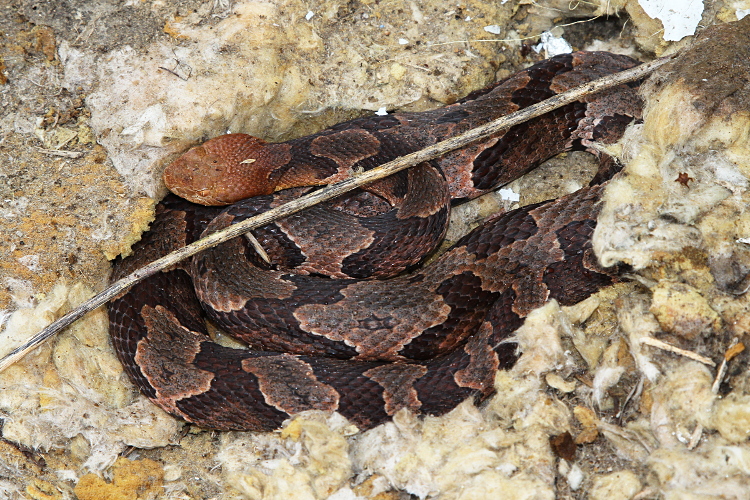
A Copperhead (Agkistrodon contortrix), as found in a carpet pile.
This one was quite large and had darker coloration than most.
I found it to be quite attractive.

A sub-adult Black Kingsnake (Lampropeltis getula nigra), found
under a piece of carpet. You can see where the carpet was in the background.
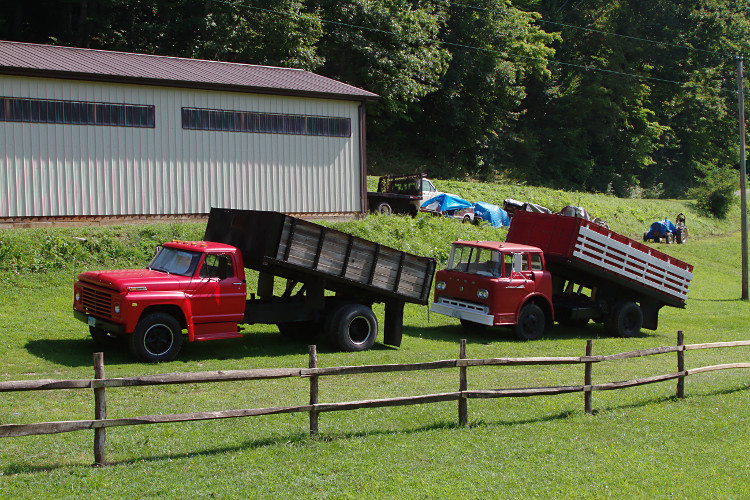
A couple of cool old Ford dump trucks I saw. The owner is obviously proud of
them -- I was happy he was showing them off.
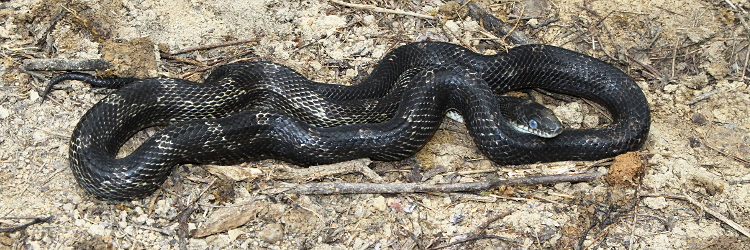
A Black Ratsnake (Elaphe obsoleta), as found under a piece of carpet.

A Common Gartersnake (Thamnophis sirtalis), as spotted basking
on a dry ridgetop. It is in pre-shed condition.
This was the third and last one that I saw this year.
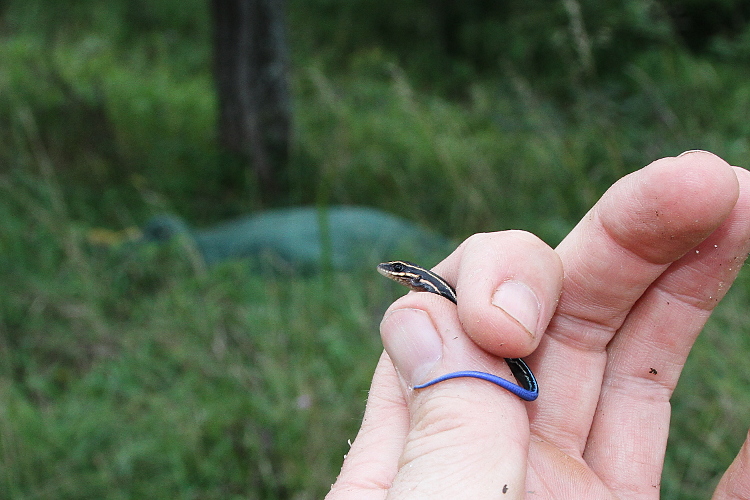
A hatchling Broad-headed Skink (Eumeces laticeps).
It was found under the carpet that you can see in the background.
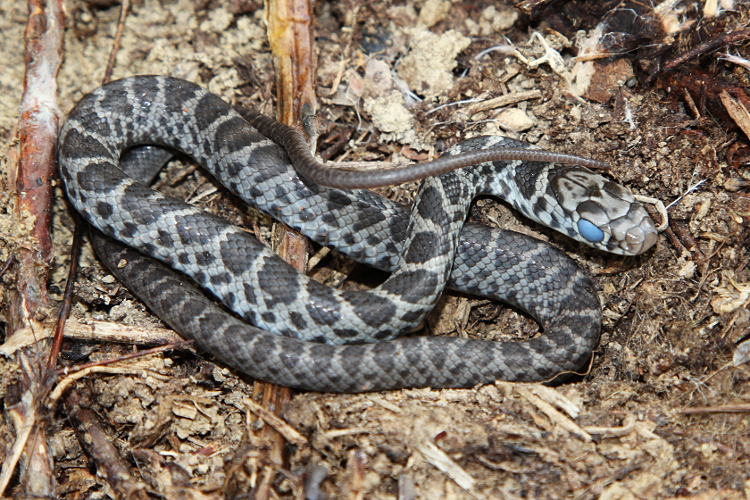
A hatchling Black Racer (Coluber constrictor),
as found under a board. It is in pre-shed condition.
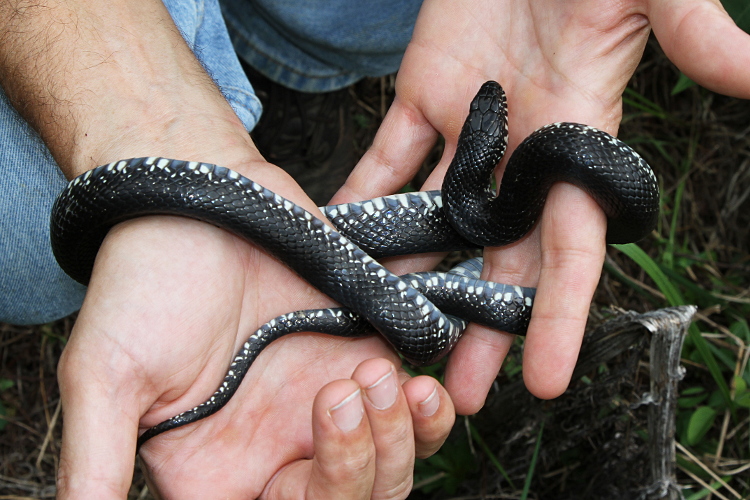
A Black Kingsnake (Lampropeltis getula nigra).
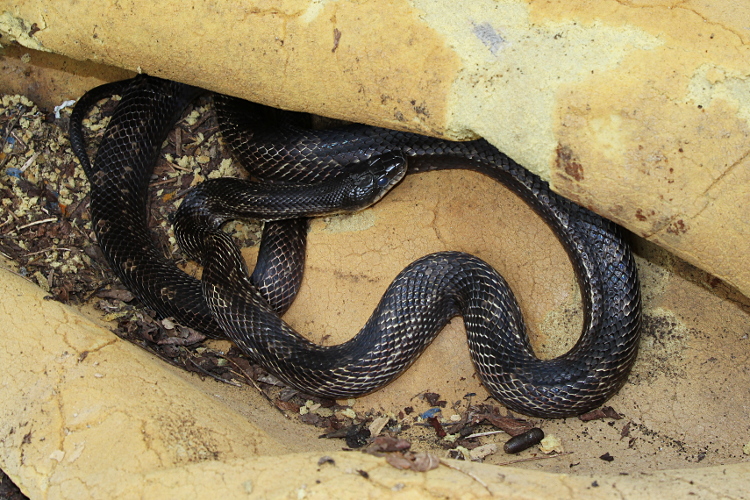
A Black Ratsnake (Elaphe obsoleta), as found in a folded up carpet pad.
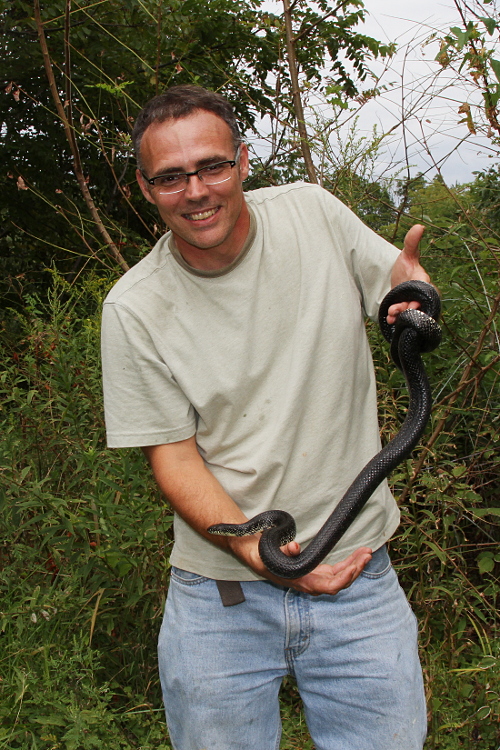
My friend Joe showing off a large 52-inch Black Kingsnake
(Lampropeltis getula nigra) that he found on August 26.
It turns out that I have also seen this snake on on July 26, 2013 and on
May 3, 2014.
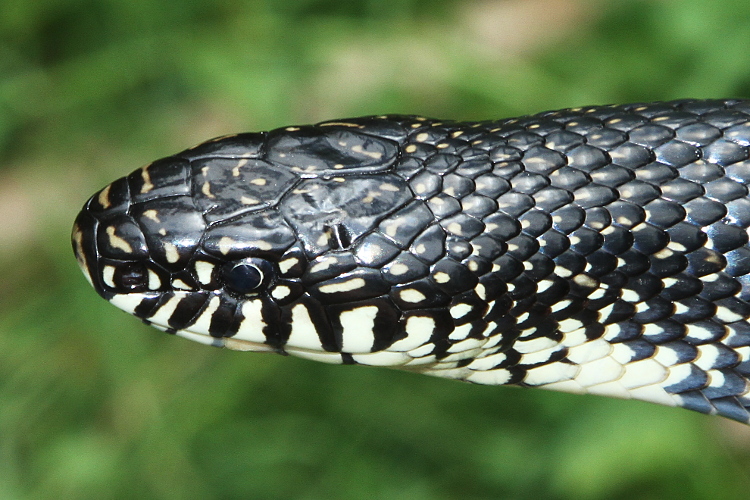
A closer look at the big King.
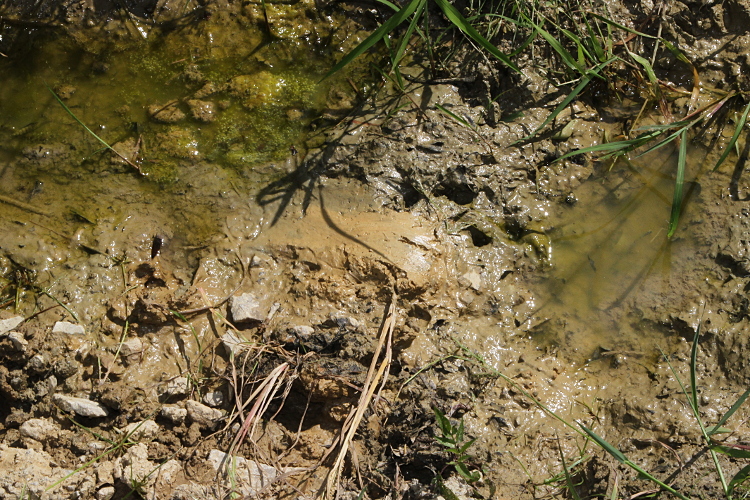
It turns out that Joe is quite the tracker. He pointed at this muddy ditch
and said that a turtle must have recently passed through. He based this on
the footprints and the smooth area you see in the center of the photo
(which turns out to be from the turtle dragging its shell).
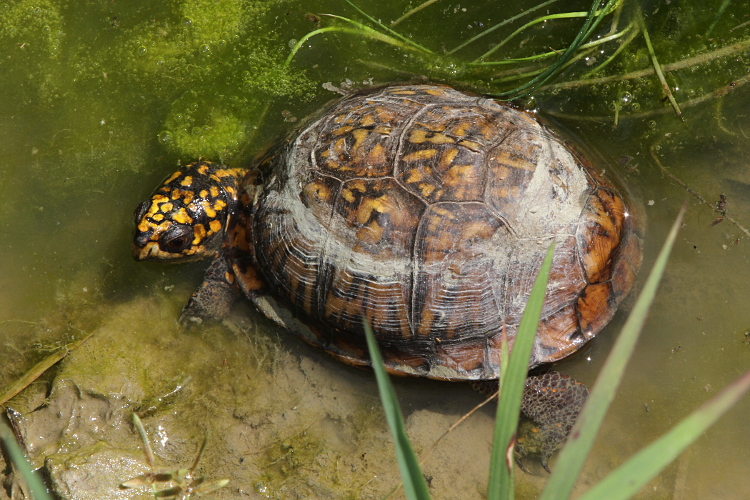
And sure enough, about 20 feet farther down the ditch, there it was --
an Eastern Box Turtle (Terrapene carolina). From the looks of its
shell, this turtle plays in the muddy water on a regular basis.
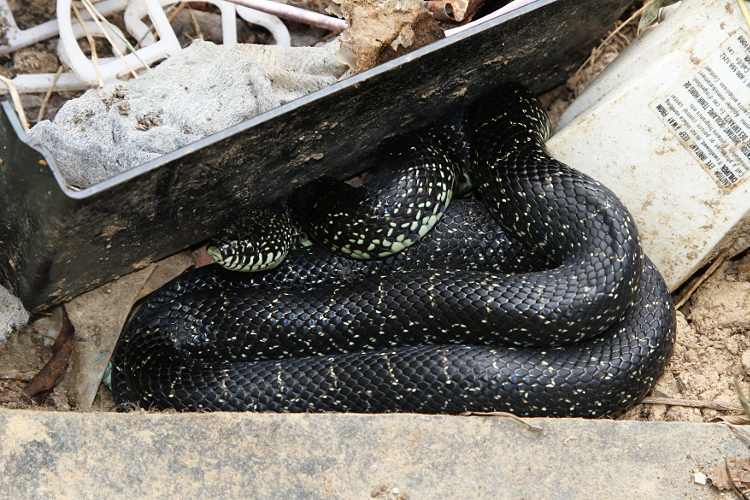
Another Black Kingsnake (Lampropeltis getula nigra). Shown as
found in a trash pile.
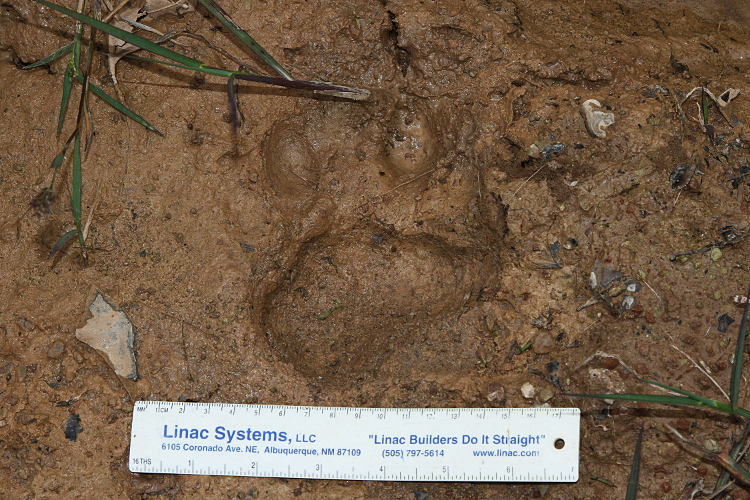
Joe also spotted this Black Bear print as we were hiking.
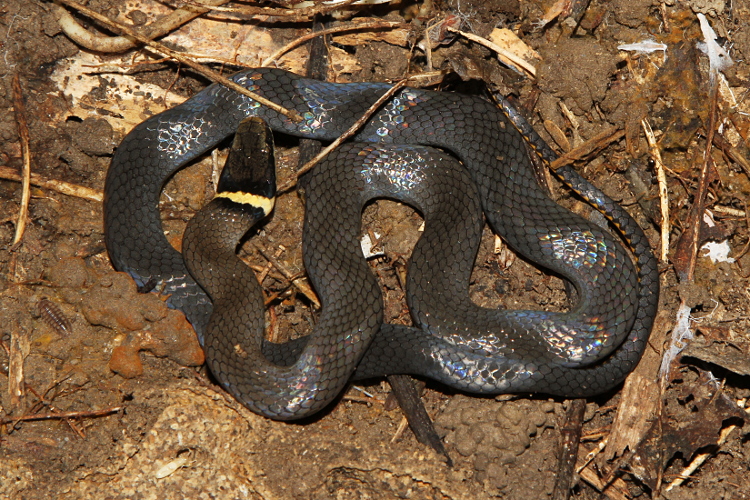
A Ringneck Snake (Diadophis punctatus), as found under cover.

I found this interesting caterpillar crawling in the leaf litter.
It turns out it is a White-blotched Hetrocampa (Heterocampa umbrata).
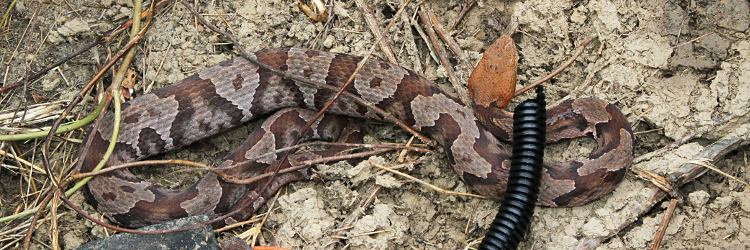
A Copperhead (Agkistrodon contortrix), as found under an old gas tank.
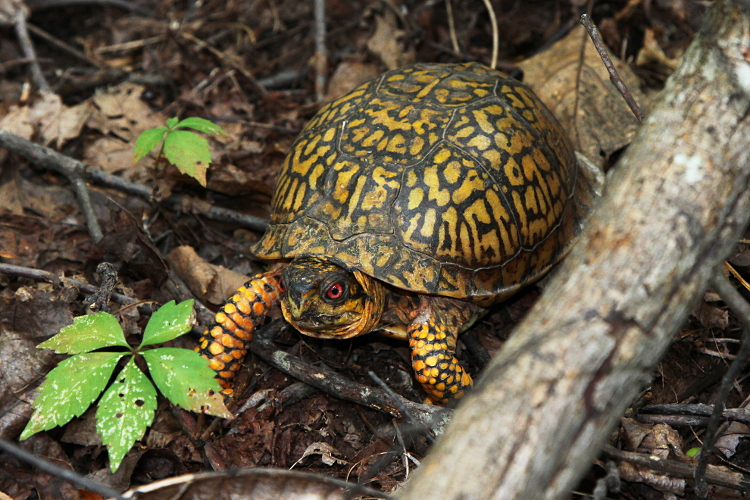
An attractive Eastern Box Turtle (Terrapene carolina).
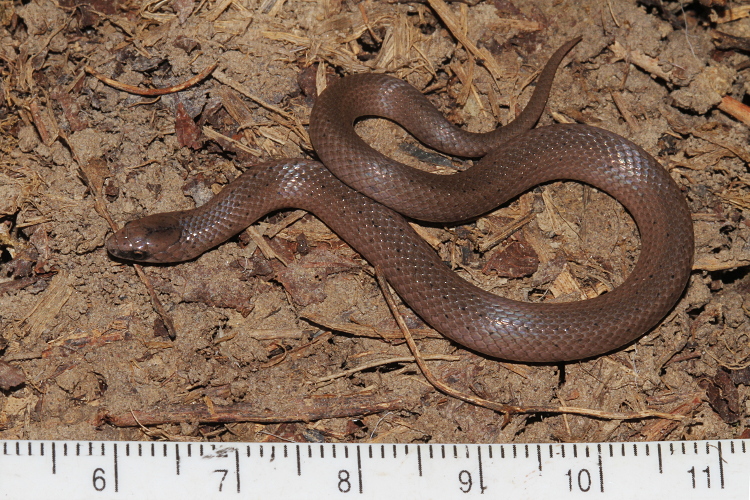
A young Smooth Earth Snake (Virginia valeriae), found on September 23.
The units on the ruler are cm. I think it was born earlier this year.
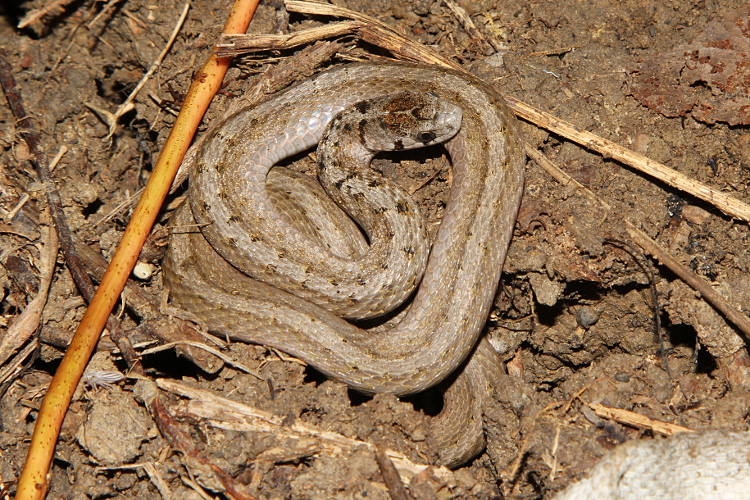
A Dekay's Snake (Storeria dekayi), as found under a discarded blanket.
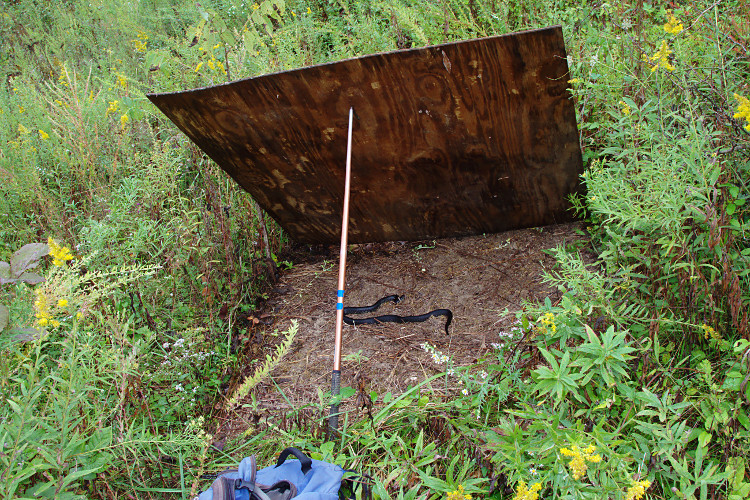
A Black Kingsnake (Lampropeltis getula nigra) on a drizzly day.
Shown as found/uncovered; the snake probably did lift its head a bit.
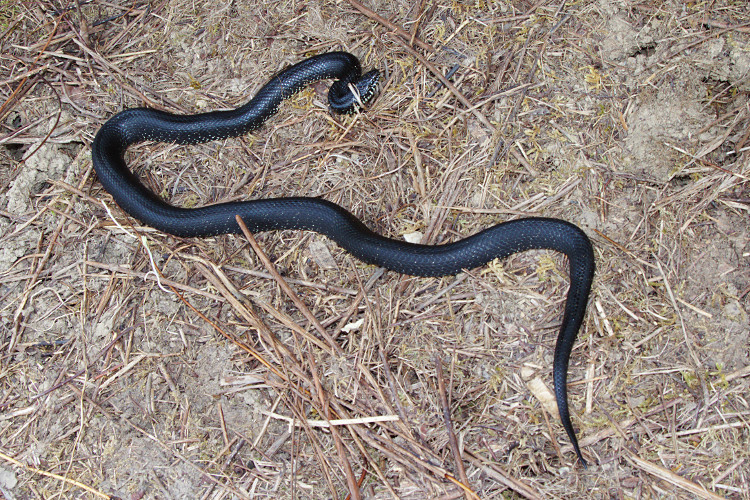
A closer look.
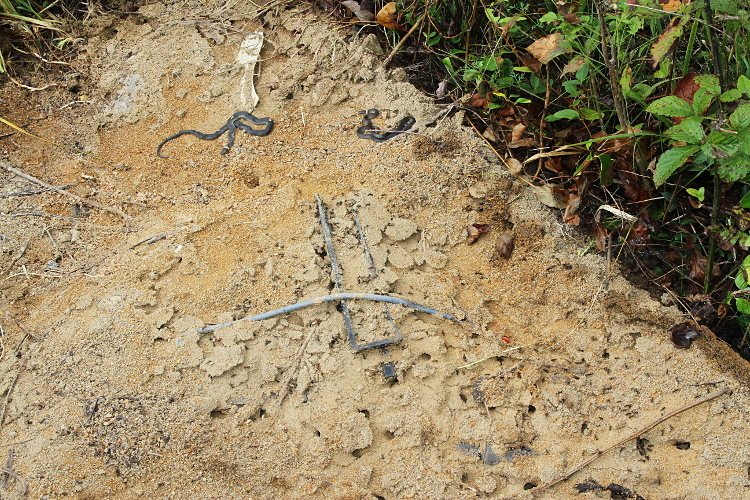
Oftentimes surface cover attracts critters besides snakes.
It is not unusual for an ant colony to decide to locate in these places.
The entire area under this piece of carpet that I lifted is
covered with dirt from fresh ant diggings. You can also see that there
were two Ringneck Snakes (Diadophis punctatus). Shown as found.
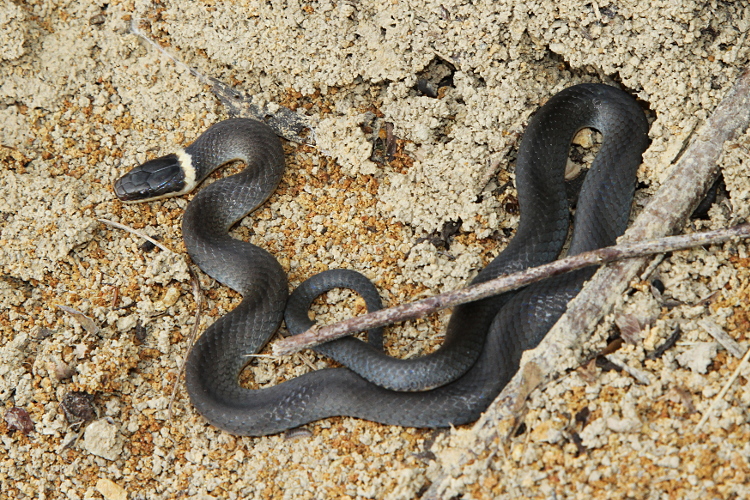
A closer look at one of them.
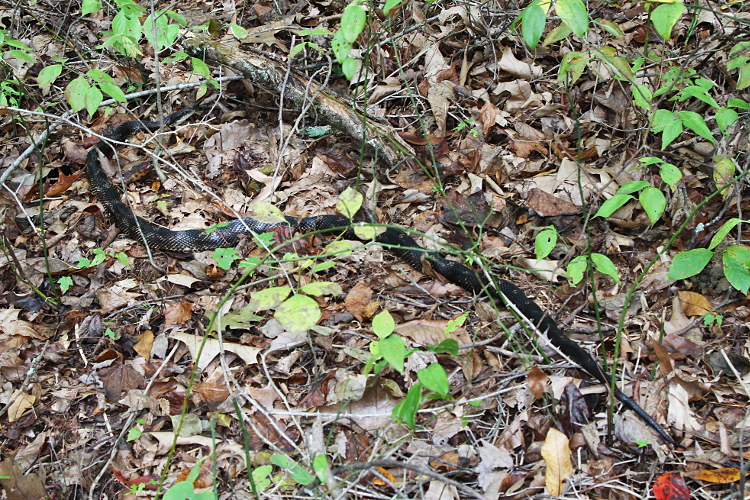
A large Black Ratsnake (Elaphe obsoleta), as found in the early fall.
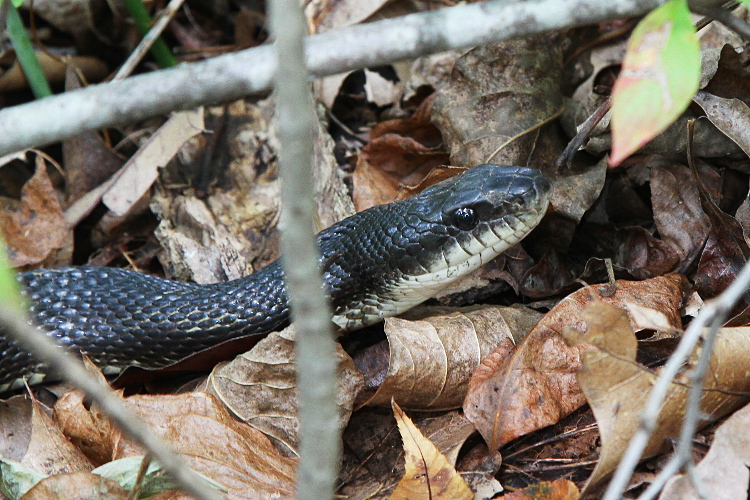
A closer look at the Black Rat.

Another cemetery, complete with cedars and yucca.
Seeing the old graves kind of puts you in your place.
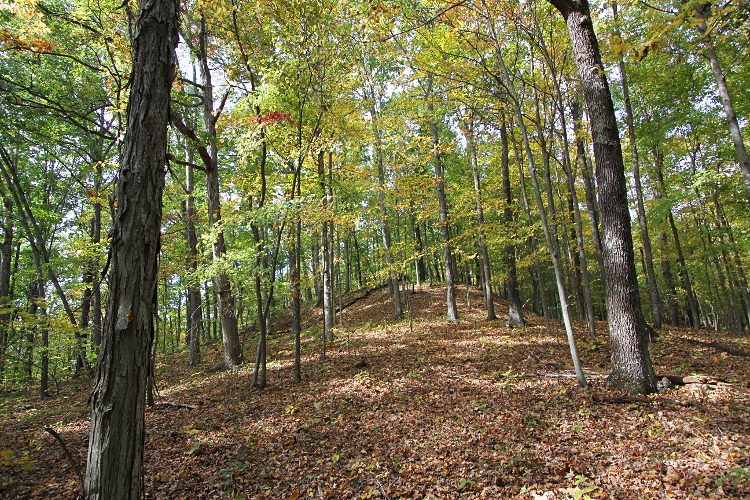
Mature oak-hickory forest is a wonderful thing.
Also very pleasant and easy to walk through.
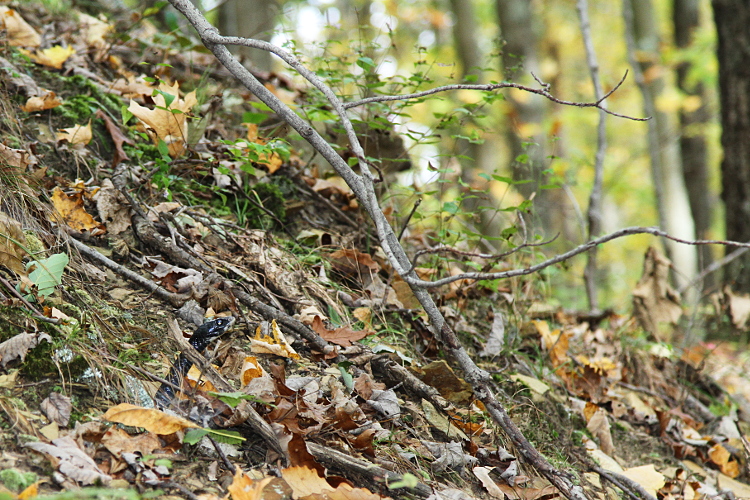
A Black Racer (Coluber constrictor), as spotted periscoping out
of a hole on a steep hillside.
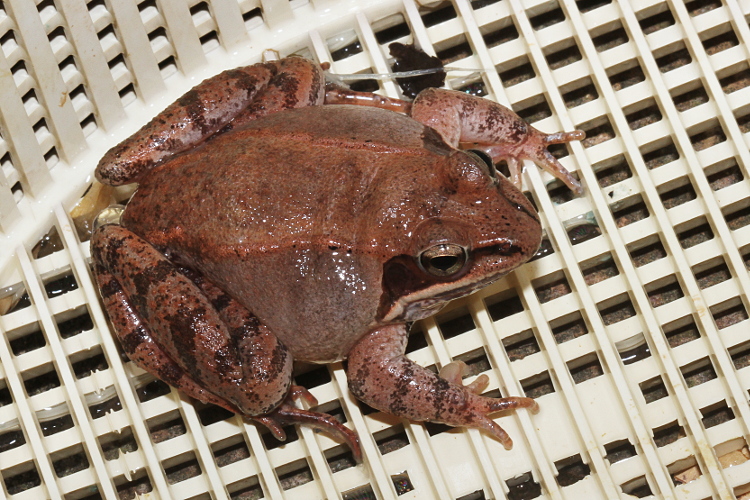
A Wood Frog (Rana sylvatica) found in our pool skimmer on October 20.
A number of them showed up in our pool this fall. I predict we will have a
record year for Wood Frog breeding in our pool next spring...
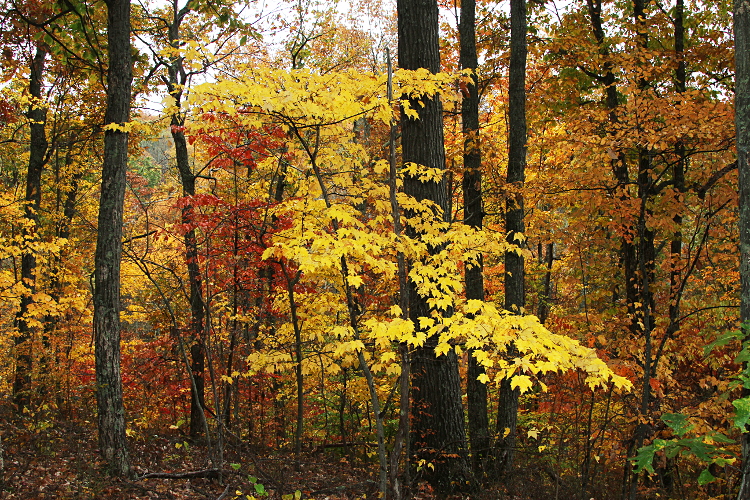
The fall colors were near their peak on October 24.
With the cloudy (and eventually drizzly) weather; they were really glowing.
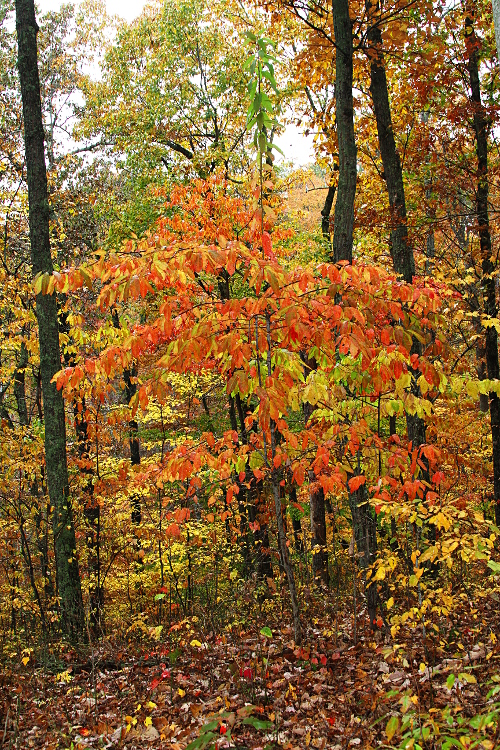
More fall colors.
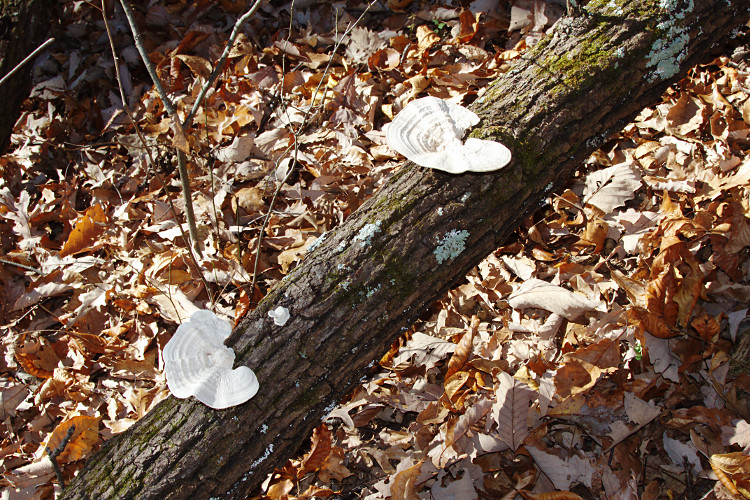
2015 was a banner year for fungus. These were seen growing on a dead log
in November.
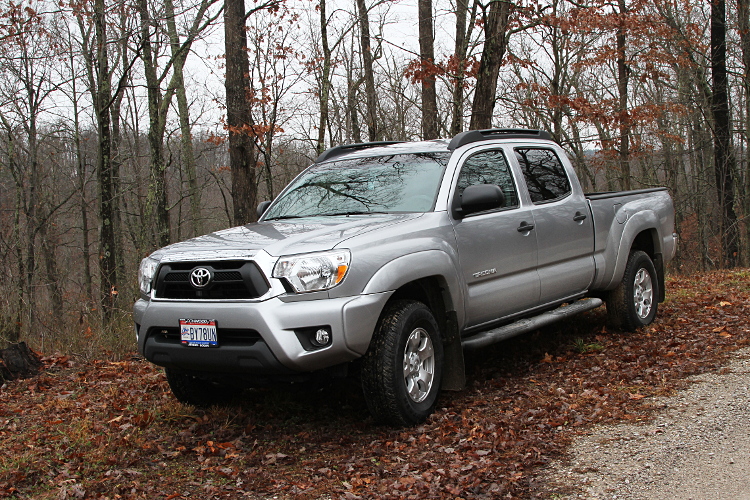
In late November I got a new truck (thanks Rox!). One nice feature is
that it is four-wheel drive. This will make it much less likely to get
stuck parking on the side of back country roads -- believe it or not, that
has been my biggest vehicular challenge around here over the years.
Well that's it for 2015. So far, winter has not really started yet
(I'm typing this on January 1, 2016). Considering the past two winters,
it will be fine with me if this trend continues.
What will 2016 bring?











































































































































































